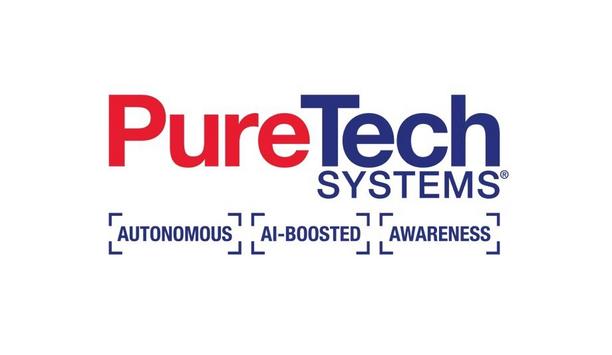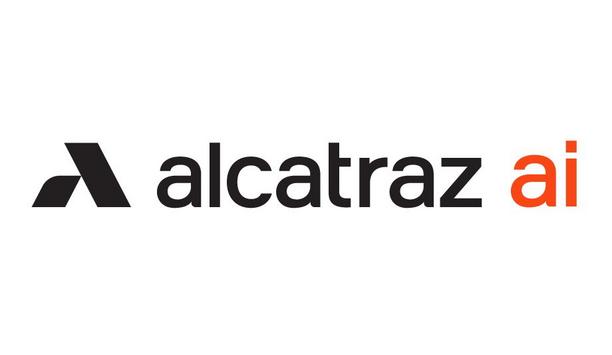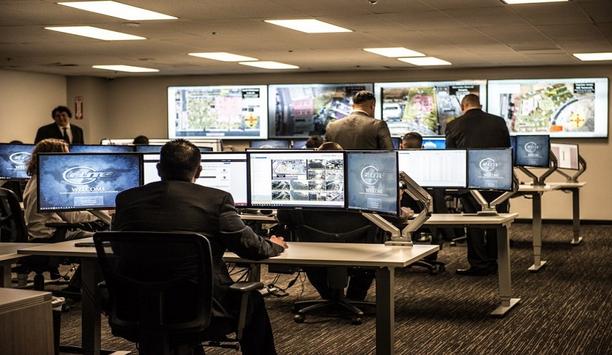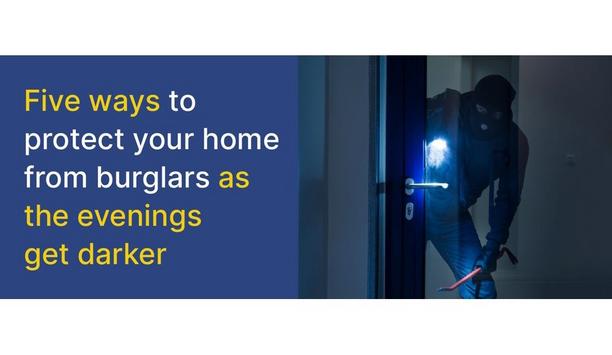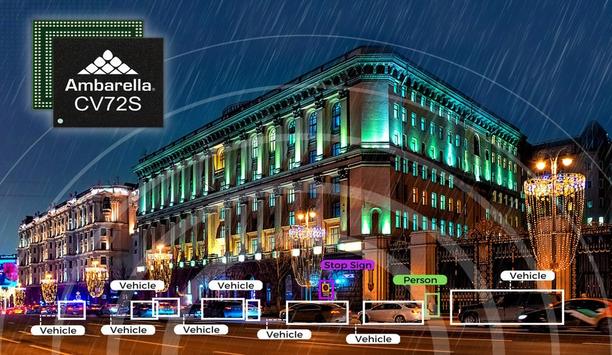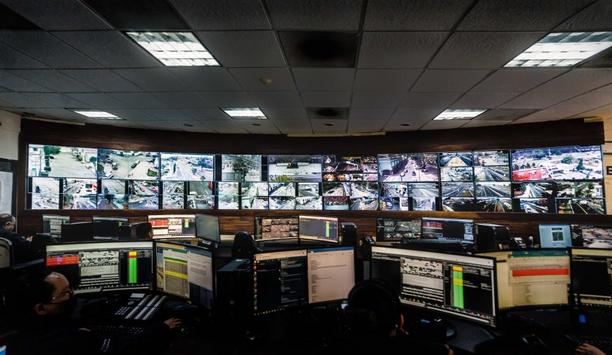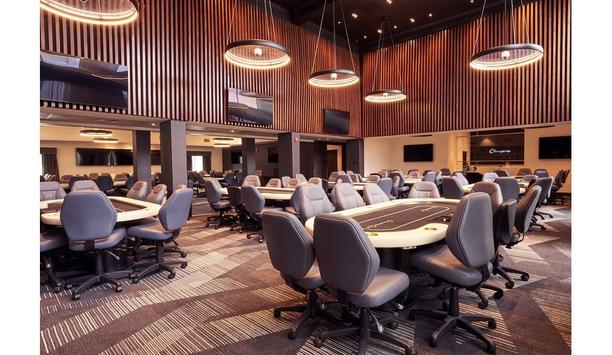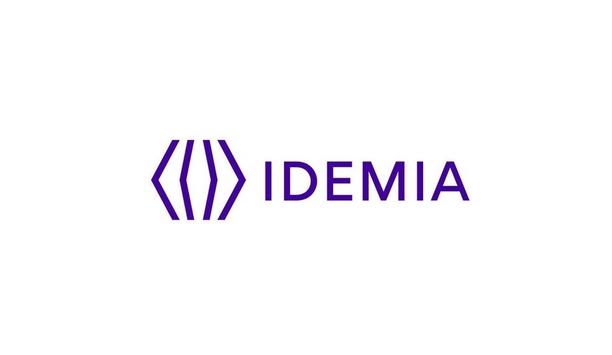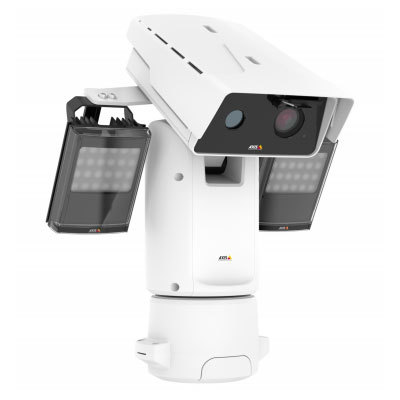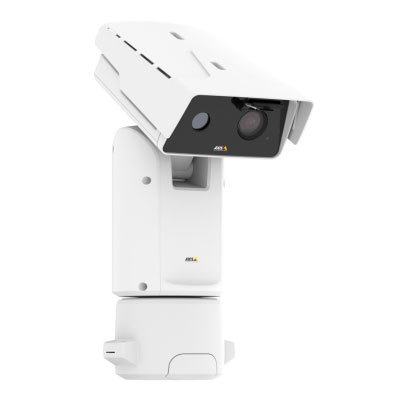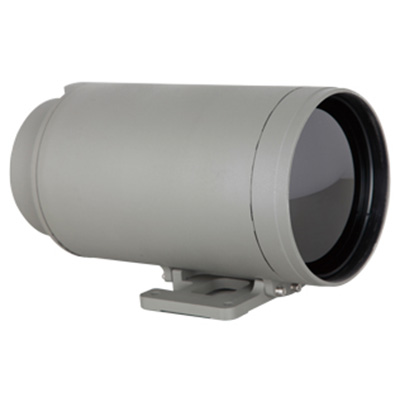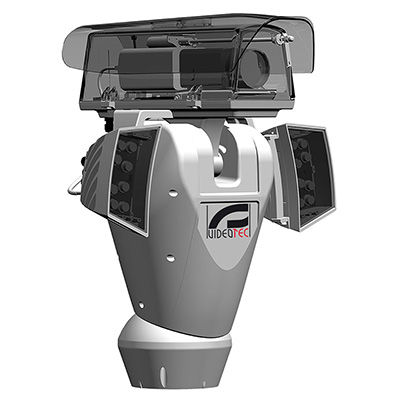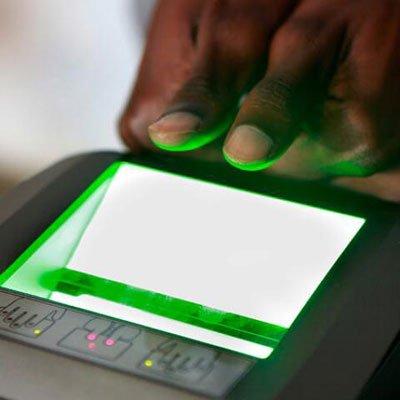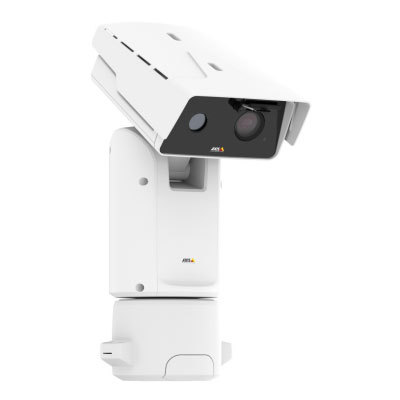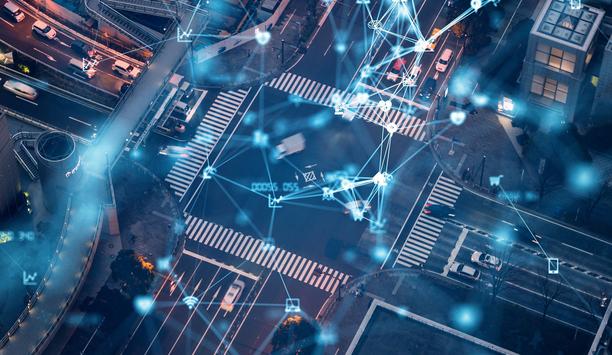Border Security
Smiths Detection, a global pioneer in threat detection and security screening and a business of Smiths Group, has announced a new partnership with NeuralGuard to advance AI-driven threat detection in security screening. NeuralGuard’s AI technology is undergoing integration and certification for use with Smiths Detection’s HI SCAN 6040 2-is. This collaboration was undertaken as part of Smiths Detection’s Ada Initiative, the company’s structured framework for accelerating...
PureTech Systems Inc., a pioneer in geospatial AI-boosted video analytics for wide-area perimeter and border security, is proud to announce the integration of its patented, award-winning SaaS solution, PurifAI™, with IMMIX’s CS & GS video monitoring platforms. This integration delivers a breakthrough in video alarm validation, significantly reducing nuisance alarms while enhancing the efficiency of both self-monitoring and central monitoring operations. PureTech’s ad...
Vemotion Interactive, the UK manufacturer of low-latency, high-performance, plug & play live video streaming solutions, has further enhanced its range of V-TX intelligent video transmission technology, employing new AI based analytics. Artificial Intelligence (AI) has long been a cornerstone of achieving ‘more with less’ in various industries, offering capabilities like pattern recognition, predictive analytics, and automation. However, its integration into video surveillance, e...
EnviriCard Retail and Trade Cards Empower Businesses to Champion Global Forests Ahead of International Day of Forests 2025, themed this year for Forests and their impact on Food Security. Carbon Quota Data Reveals Enviricard Products Slash Carbon Footprint to 57% of that for PVC Plastic Cards, Driving Sustainable Choices for Forest Conservation Sustainability in your wallet Enviricard empowers businesses and consumers to protect global forests through climate-friendly choices Enviricar...
Eviden, the Atos Group business pioneer in digital, cloud, big data and security announces a strategic collaboration with Supermicro to distribute Supermicro’s AI SuperCluster with NVIDIA GB200 NVL72 solutions, across Europe, India, Middle-East and South America. This collaboration underscores both companies' commitment to advance enterprise AI capabilities and deliver innovative solutions to meet the growing demand for trillion parameter AI models training and inference. Optimized...
Allied Universal® today announced that Taylor Carr has joined its Technology Services business unit as senior vice president of operations. In this role, Carr will oversee operations and drive growth across all revenue segments of the business. Experienced industry leader Carr has more than 25 years of experience in the technology and security industriesCarr has more than 25 years of experience in the technology and security industries. Most recently he served as president for Visi...
News
Alcatraz AI, a global provider of frictionless, AI-powered biometric access control solutions revolutionising security through facial authentication, announced the appointment of Rick Nee as the company’s new Chief Revenue Officer (CRO). Joining at a key time for company growth in parallel with the increasing demands for solutions in the security market, Nee brings with him vast experience in developing and scaling successful go-to-market teams. Increasing demands for solutions With over 15 years of sales experience, Nee joins Alcatraz AI to execute the company’s sales strategy at a momentous time for industry opportunity and growth. Nee’s data center expertise will be paramount as Alcatraz AI expands its pioneering presence in this sector for biometric access control in 2025. Work experience Nee is well-versed in pioneering under pressure and directing teams with collaboration and motivation Nee is an experienced security sales executive and data-driven pioneer with a proven track record of driving revenue growth through strategic leadership efforts and market strategies. With an extensive background of unique leadership experiences in both the military and market sales environments, Nee is well-versed in pioneering under pressure and directing teams with collaboration and motivation to meet objectives. Sales approach Nee’s interest in security and technology developed during his time as a Marine Corps Infantry Officer, where he used security as his foundation in pioneering teams and was inspired to pursue a career to apply these lessons on a broader scale. Nee returned to school to earn his MBA at Syracuse University and kick-started his career, earning experience scaling operations in large enterprises and navigating the fast-paced demand of startups with his sales approach. Data-driven analytics He came to Alcatraz AI, most recently from Authentic8, where he held the position of Head of Sales. With Authentic8, Nee grew the company’s go-to-market team more than tenfold across four functions, joined early stage and doubled the annual recurring revenue (ARR) to nearly $50M, and secured partnerships with over 500 government and enterprise customers. He also utilised data-driven analytics to make informed decisions while pioneering his team in addressing pressing security challenges, including insider threats, executive protection, fraud prevention, and election security. Expanding Alcatraz AI’s presence Nee will contribute to Alcatraz AI’s success in key verticals, including data centers, hyperscalers, financial institutions With Alcatraz AI, Nee will serve as the company’s primary sales pioneer. Nee will play an important role in building and empowering the sales team, expanding Alcatraz AI’s market presence, and fostering strong relationships with the company’s partners and customers. With a focus on market trends, Nee will contribute to Alcatraz AI’s success in key verticals, including data centers, hyperscalers, financial institutions, critical infrastructure, higher education facilities, and more. Tina's comment “We’re honoured to welcome Rick to our expanding executive leadership team at Alcatraz AI and to have him join our sales department. As the industry continues to grow, Rick will be a valuable asset in helping Alcatraz AI achieve impactful results,” said Tina D’Agostin, CEO of Alcatraz AI. “His strong sales growth track record, cybersecurity background, and ability to build powerhouse teams will be key in helping Alcatraz AI broaden its efforts to keep individuals and enterprises safer as technology continues to evolve.” Innovation, security, and privacy “I’m excited to become a key member of the Alcatraz AI executive team and to contribute to the company’s commitment to innovation, security, and privacy in a growing industry,” said Nee. “As the security industry advances with the emergence of new technologies, policies, and security threats, I’m eager to help grow Alcatraz AI’s sales efforts and accelerate the adoption of their access control solutions across diverse industries. I look forward to working with the team to deliver exceptional value to our customers through seamless integration that meets the highest privacy and security standards.”
OSI Systems, Inc. announced that its Security division received an order valued at approximately $23 million to assist in the deployment and integration of long-range radio frequency (RF) critical communication systems. As part of the award, the Company is expected to provide critical hardware as well as technical services designed to enhance the long-term availability of US government strategic RF communications capability in critical regions of the world. Protecting people and infrastructure OSI Systems’ President and CEO, Ajay Mehra, commented, “With our recent acquisition of an RF-based critical solutions business serving defence customers, the Security division further expanded its product portfolio for the protection of people and infrastructure." "We are pleased with this notable award and look forward to supporting this long-standing customer’s efforts to upgrade and enhance US secure communications.”
PureTech Systems Inc., a pioneer in geospatial AI-boosted video analytics for wide-area perimeter and border security, announced the successful completion of system acceptance testing at a major U.S. metropolitan rapid transit agency. The testing demonstrated the company’s capability to address a significant safety and operational challenge: detecting debris and items on transit tracks to mitigate disruptions and enhance commuter safety. PureTech's RIDS Solution PureTech's RIDS for Rapid Transit agencies proved to be a game-changer by detecting obstacles The rapid transit agency sought a reliable, time-tested solution to combat recurring issues with objects coming onto the tracks—posing risks to passenger safety, causing costly delays, and disrupting the efficiency of the transit system. PureTech's RIDS Solution for Rapid Transit agencies, powered by its patented, geospatial AI-boosted video analytics, proved to be a game-changer by accurately detecting obstacles on the tracks in real-time. PureTech Systems’ commitment “This testing underscores PureTech Systems’ commitment to innovation in protecting critical infrastructure and enhancing public safety,” said Larry Bowe, President of PureTech Systems Inc. “The successful testing demonstrates our ability to provide precise, reliable, and scalable solutions for the unique challenges faced by rapid transit agencies.” Key highlights of the system High Precision Detection: The RIDS system achieved exceptional accuracy in identifying and locating obstacles on the tracks with nearly zero nuisance detections, even in high-traffic and low-visibility conditions. Real-Time Alerts: Operators receive immediate notifications, enabling rapid response and minimising operational disruptions. Seamless Integration: The system seamlessly integrates into the transit agency’s existing infrastructure, ensuring operational continuity. PureTech Systems’ reputation The successful testing reinforces PureTech Systems’ reputation as a trusted provider of innovative solutions for critical infrastructure protection. As urban areas continue to rely on rapid transit systems, the ability to proactively address track safety challenges will play an increasingly vital role in ensuring the smooth and safe operation of these essential services.
The UK’s Security & Policing 2025 expo opened in Hampshire, bringing together government officials, law enforcement agencies and policing-tech vendors to discuss the latest developments in public safety and security. This year the event will focus on counter-terrorism, border security, cyber threats and the use of AI in policing. Tech companies to watch Thales will showcase its AI-driven border security solutions, which are designed to support identity verification processes at international checkpoints. The company has been involved in developing systems used in automated border control and passenger screening. NEC Corporation will present its facial recognition systems, which have been deployed in various public security settings. AI-based video technology Digital Barriers is a provider of AI-based video technology aimed at enhancing real-time decision-making The Japanese company’s technology has been used in airports, transport hubs and by law enforcement agencies for identification and verification purposes. Digital Barriers is a provider of AI-based video technology aimed at enhancing real-time decision-making for law enforcement, public safety and other critical sectors. The company’s secure edge platform and patented video compression tech are used across various industries including city law enforcement, defense, transportation and events, to provide instant insights from real-time video feeds. Facial recognition in UK policing The use of facial recognition technology by UK police continues to expand. A recent transparency report from Essex Police detailed the results of 38 deployments of live facial recognition. Over 383,000 match attempts were made using software from Corsight AI and Digital Barriers, with only one false alert recorded. During these operations, the system generated 61 alerts leading to 11 arrests, including suspects wanted for assault and sexual offenses. AI-driven surveillance tools Police statistics show that these tools help speed up studies and improve public safety The accuracy rate of the technology, according to the report, was 99.9997%. With rising crime rates and growing security concerns, facial recognition and AI-driven surveillance tools are becoming more widely adopted. Police statistics show that these tools help speed up investigations and improve public safety. Corsight AI will also present its advanced facial intelligence platform at Security & Policing 2025, showcasing its capabilities in real-time watchlist alerting and forensic investigations. Future of AI in crime prevention Corsight AI President Rob Watts commented on the growing demand for AI-driven policing solutions: "In many regions, we are witnessing an increase in violent crime and various threats to personal safety. This directly fuels the demand for effective and efficient law enforcement, often including the implementation of facial intelligence tech for real-time watchlist alerting and after-the-fact forensic investigations." "If you're a Western police force needing to reliably identify people in real-world conditions like outdoor darkness and in motion, you have very few options." Security & Policing 2025 will provide a platform to explore these issues further, as law enforcement agencies and tech providers look at the future of AI in crime prevention and public security.
International cybersecurity and medical imaging IT company Sectra (STO: SECT B) is delivering a system with hardened, secure mobile devices to the Swedish Prison and Probation Service. The solution will streamline the day-to-day work of the Prison and Probation Service’s employees and also provide inmates with controlled, secure access to digital services and information. The system has been developed to protect against various security risks and threats, both internal and external. Innovative security solutions This solution enhances efficiency for prison staff while providing inmates with controlled accessThe solution, which is based on Sectra’s long-standing experience in secure communication and information security, was developed in close collaboration with the Swedish Prison and Probation Service. It streamlines the administrative work of the Prison and Probation Service’s employees while still maintaining a high level of security. It also provides inmates with highly controlled access to several digital services, including educational material. In addition to making day-to-day routines more efficient and secure, the Prison and Probation Service can also implement new services in the solution as society at large continues to go digital. Streamlining legal processes The system also simplifies the Prison and Probation Service’s distribution and management of preliminary investigation material. By combining privacy and secure access, the solution can play a role in upholding due process and streamlining legal proceedings in a way that was not previously possible. Secure digital transformation “The Prison and Probation Service has an important job in maintaining and continuously developing an effective criminal justice system. The authority plans to triple the number of prison places in the coming years and a prerequisite for succeeding with this is technological development in client-orientated activities.” “Through our collaboration, we are able to contribute our experience in creating solutions for secure digitization. The solution helps to streamline the work of the Prison and Probation Service, but could also help similar authorities going through the same kind of digitization journey,” says Magnus Skogberg, President of Sectra Communications. Strengthening Digital Security The contract with the Swedish Prison and Probation Service includes ongoing production and delivery of Sectra’s hardened, secure devices along with components that enable easy maintenance and configuration. These additions are designed to slot into the Prison and Probation Service’s existing IT infrastructure both technically and operationally, ensuring an effective work process.
Iris ID, a global pioneer in iris recognition technology since 1997 has secured a significant new partnership with the Texas Department of Public Safety (TDPS), to add over two hundred more Iris ID iCAM TD100A units to their Livescan systems. This further cements the growing popularity and efficacy of iris recognition technology for law enforcement, criminal justice agencies, and their partners. As a biometric, iris recognition is deemed the most accurate modality over either fingerprint or facial recognition, and is second only to DNA. Iris ID iCAM TD100A units The TDPS is responsible for protecting its 30 million residents, the states’ critical infrastructures, and over 1,254 miles of international border with Mexico. The threats that the DPS monitors require constant vigilance and the most up-to-date and efficient technologies. Faced with limited resources and a growing criminal contingent, this technology is poised to assist law enforcement and state agencies with protecting citizens and property, while providing local and state law enforcement and criminal justice agencies with around-the-clock access to mission-critical information systems, like the Next Generation Identification Iris Service (NGI). 1-N identification This repository is indispensable, as it provides an iris-only search capability that provides 1-N identification In 2014, Iris ID began the (NGI), a pilot program with Border Patrol and the FBI, which gave law enforcement and government agencies access to the largest repository of iris biometric data associated with fingerprint and face images. This repository is indispensable, as it provides an iris-only search capability that provides 1-N identification - speeding the intake and matching process of detainees. NGI platform In 2020, the FBI officially rolled out the NGI platform. Since 2020, the repository has been growing at a rate of 100k+ new identities monthly. There are currently about 675 law enforcement locations in the US contributing to NGI Iris Service from 250 agencies and we expect to see that number continue to grow. Department of Homeland Security (DHS), Border Patrol has over 2000 workstations installed enrolling to NGI every day. Iris recognition As a tool to aid law enforcement and criminal justice agencies, iris recognition is useful in scenarios that require fast, accurate, and non-contact identification. Use cases include intake and release, work release, transportation, mobile identification, border security, and investigative searches.
Alcatraz AI, a global provider of frictionless, AI-powered biometric access control solutions revolutionising security through facial authentication, announced the appointment of Rick Nee as the company’s new Chief Revenue Officer (CRO). Joining at a key time for company growth in parallel with the increasing demands for solutions in the security market, Nee brings with him vast experience in developing and scaling successful go-to-market teams. Increasing demands for solutions With over 15 years of sales experience, Nee joins Alcatraz AI to execute the company’s sales strategy at a momentous time for industry opportunity and growth. Nee’s data center expertise will be paramount as Alcatraz AI expands its pioneering presence in this sector for biometric access control in 2025. Work experience Nee is well-versed in pioneering under pressure and directing teams with collaboration and motivation Nee is an experienced security sales executive and data-driven pioneer with a proven track record of driving revenue growth through strategic leadership efforts and market strategies. With an extensive background of unique leadership experiences in both the military and market sales environments, Nee is well-versed in pioneering under pressure and directing teams with collaboration and motivation to meet objectives. Sales approach Nee’s interest in security and technology developed during his time as a Marine Corps Infantry Officer, where he used security as his foundation in pioneering teams and was inspired to pursue a career to apply these lessons on a broader scale. Nee returned to school to earn his MBA at Syracuse University and kick-started his career, earning experience scaling operations in large enterprises and navigating the fast-paced demand of startups with his sales approach. Data-driven analytics He came to Alcatraz AI, most recently from Authentic8, where he held the position of Head of Sales. With Authentic8, Nee grew the company’s go-to-market team more than tenfold across four functions, joined early stage and doubled the annual recurring revenue (ARR) to nearly $50M, and secured partnerships with over 500 government and enterprise customers. He also utilised data-driven analytics to make informed decisions while pioneering his team in addressing pressing security challenges, including insider threats, executive protection, fraud prevention, and election security. Expanding Alcatraz AI’s presence Nee will contribute to Alcatraz AI’s success in key verticals, including data centers, hyperscalers, financial institutions With Alcatraz AI, Nee will serve as the company’s primary sales pioneer. Nee will play an important role in building and empowering the sales team, expanding Alcatraz AI’s market presence, and fostering strong relationships with the company’s partners and customers. With a focus on market trends, Nee will contribute to Alcatraz AI’s success in key verticals, including data centers, hyperscalers, financial institutions, critical infrastructure, higher education facilities, and more. Tina's comment “We’re honoured to welcome Rick to our expanding executive leadership team at Alcatraz AI and to have him join our sales department. As the industry continues to grow, Rick will be a valuable asset in helping Alcatraz AI achieve impactful results,” said Tina D’Agostin, CEO of Alcatraz AI. “His strong sales growth track record, cybersecurity background, and ability to build powerhouse teams will be key in helping Alcatraz AI broaden its efforts to keep individuals and enterprises safer as technology continues to evolve.” Innovation, security, and privacy “I’m excited to become a key member of the Alcatraz AI executive team and to contribute to the company’s commitment to innovation, security, and privacy in a growing industry,” said Nee. “As the security industry advances with the emergence of new technologies, policies, and security threats, I’m eager to help grow Alcatraz AI’s sales efforts and accelerate the adoption of their access control solutions across diverse industries. I look forward to working with the team to deliver exceptional value to our customers through seamless integration that meets the highest privacy and security standards.”
OSI Systems, Inc. announced that its Security division received an order valued at approximately $23 million to assist in the deployment and integration of long-range radio frequency (RF) critical communication systems. As part of the award, the Company is expected to provide critical hardware as well as technical services designed to enhance the long-term availability of US government strategic RF communications capability in critical regions of the world. Protecting people and infrastructure OSI Systems’ President and CEO, Ajay Mehra, commented, “With our recent acquisition of an RF-based critical solutions business serving defence customers, the Security division further expanded its product portfolio for the protection of people and infrastructure." "We are pleased with this notable award and look forward to supporting this long-standing customer’s efforts to upgrade and enhance US secure communications.”
PureTech Systems Inc., a pioneer in geospatial AI-boosted video analytics for wide-area perimeter and border security, announced the successful completion of system acceptance testing at a major U.S. metropolitan rapid transit agency. The testing demonstrated the company’s capability to address a significant safety and operational challenge: detecting debris and items on transit tracks to mitigate disruptions and enhance commuter safety. PureTech's RIDS Solution PureTech's RIDS for Rapid Transit agencies proved to be a game-changer by detecting obstacles The rapid transit agency sought a reliable, time-tested solution to combat recurring issues with objects coming onto the tracks—posing risks to passenger safety, causing costly delays, and disrupting the efficiency of the transit system. PureTech's RIDS Solution for Rapid Transit agencies, powered by its patented, geospatial AI-boosted video analytics, proved to be a game-changer by accurately detecting obstacles on the tracks in real-time. PureTech Systems’ commitment “This testing underscores PureTech Systems’ commitment to innovation in protecting critical infrastructure and enhancing public safety,” said Larry Bowe, President of PureTech Systems Inc. “The successful testing demonstrates our ability to provide precise, reliable, and scalable solutions for the unique challenges faced by rapid transit agencies.” Key highlights of the system High Precision Detection: The RIDS system achieved exceptional accuracy in identifying and locating obstacles on the tracks with nearly zero nuisance detections, even in high-traffic and low-visibility conditions. Real-Time Alerts: Operators receive immediate notifications, enabling rapid response and minimising operational disruptions. Seamless Integration: The system seamlessly integrates into the transit agency’s existing infrastructure, ensuring operational continuity. PureTech Systems’ reputation The successful testing reinforces PureTech Systems’ reputation as a trusted provider of innovative solutions for critical infrastructure protection. As urban areas continue to rely on rapid transit systems, the ability to proactively address track safety challenges will play an increasingly vital role in ensuring the smooth and safe operation of these essential services.
The UK’s Security & Policing 2025 expo opened in Hampshire, bringing together government officials, law enforcement agencies and policing-tech vendors to discuss the latest developments in public safety and security. This year the event will focus on counter-terrorism, border security, cyber threats and the use of AI in policing. Tech companies to watch Thales will showcase its AI-driven border security solutions, which are designed to support identity verification processes at international checkpoints. The company has been involved in developing systems used in automated border control and passenger screening. NEC Corporation will present its facial recognition systems, which have been deployed in various public security settings. AI-based video technology Digital Barriers is a provider of AI-based video technology aimed at enhancing real-time decision-making The Japanese company’s technology has been used in airports, transport hubs and by law enforcement agencies for identification and verification purposes. Digital Barriers is a provider of AI-based video technology aimed at enhancing real-time decision-making for law enforcement, public safety and other critical sectors. The company’s secure edge platform and patented video compression tech are used across various industries including city law enforcement, defense, transportation and events, to provide instant insights from real-time video feeds. Facial recognition in UK policing The use of facial recognition technology by UK police continues to expand. A recent transparency report from Essex Police detailed the results of 38 deployments of live facial recognition. Over 383,000 match attempts were made using software from Corsight AI and Digital Barriers, with only one false alert recorded. During these operations, the system generated 61 alerts leading to 11 arrests, including suspects wanted for assault and sexual offenses. AI-driven surveillance tools Police statistics show that these tools help speed up studies and improve public safety The accuracy rate of the technology, according to the report, was 99.9997%. With rising crime rates and growing security concerns, facial recognition and AI-driven surveillance tools are becoming more widely adopted. Police statistics show that these tools help speed up investigations and improve public safety. Corsight AI will also present its advanced facial intelligence platform at Security & Policing 2025, showcasing its capabilities in real-time watchlist alerting and forensic investigations. Future of AI in crime prevention Corsight AI President Rob Watts commented on the growing demand for AI-driven policing solutions: "In many regions, we are witnessing an increase in violent crime and various threats to personal safety. This directly fuels the demand for effective and efficient law enforcement, often including the implementation of facial intelligence tech for real-time watchlist alerting and after-the-fact forensic investigations." "If you're a Western police force needing to reliably identify people in real-world conditions like outdoor darkness and in motion, you have very few options." Security & Policing 2025 will provide a platform to explore these issues further, as law enforcement agencies and tech providers look at the future of AI in crime prevention and public security.
International cybersecurity and medical imaging IT company Sectra (STO: SECT B) is delivering a system with hardened, secure mobile devices to the Swedish Prison and Probation Service. The solution will streamline the day-to-day work of the Prison and Probation Service’s employees and also provide inmates with controlled, secure access to digital services and information. The system has been developed to protect against various security risks and threats, both internal and external. Innovative security solutions This solution enhances efficiency for prison staff while providing inmates with controlled accessThe solution, which is based on Sectra’s long-standing experience in secure communication and information security, was developed in close collaboration with the Swedish Prison and Probation Service. It streamlines the administrative work of the Prison and Probation Service’s employees while still maintaining a high level of security. It also provides inmates with highly controlled access to several digital services, including educational material. In addition to making day-to-day routines more efficient and secure, the Prison and Probation Service can also implement new services in the solution as society at large continues to go digital. Streamlining legal processes The system also simplifies the Prison and Probation Service’s distribution and management of preliminary investigation material. By combining privacy and secure access, the solution can play a role in upholding due process and streamlining legal proceedings in a way that was not previously possible. Secure digital transformation “The Prison and Probation Service has an important job in maintaining and continuously developing an effective criminal justice system. The authority plans to triple the number of prison places in the coming years and a prerequisite for succeeding with this is technological development in client-orientated activities.” “Through our collaboration, we are able to contribute our experience in creating solutions for secure digitization. The solution helps to streamline the work of the Prison and Probation Service, but could also help similar authorities going through the same kind of digitization journey,” says Magnus Skogberg, President of Sectra Communications. Strengthening Digital Security The contract with the Swedish Prison and Probation Service includes ongoing production and delivery of Sectra’s hardened, secure devices along with components that enable easy maintenance and configuration. These additions are designed to slot into the Prison and Probation Service’s existing IT infrastructure both technically and operationally, ensuring an effective work process.
Iris ID, a global pioneer in iris recognition technology since 1997 has secured a significant new partnership with the Texas Department of Public Safety (TDPS), to add over two hundred more Iris ID iCAM TD100A units to their Livescan systems. This further cements the growing popularity and efficacy of iris recognition technology for law enforcement, criminal justice agencies, and their partners. As a biometric, iris recognition is deemed the most accurate modality over either fingerprint or facial recognition, and is second only to DNA. Iris ID iCAM TD100A units The TDPS is responsible for protecting its 30 million residents, the states’ critical infrastructures, and over 1,254 miles of international border with Mexico. The threats that the DPS monitors require constant vigilance and the most up-to-date and efficient technologies. Faced with limited resources and a growing criminal contingent, this technology is poised to assist law enforcement and state agencies with protecting citizens and property, while providing local and state law enforcement and criminal justice agencies with around-the-clock access to mission-critical information systems, like the Next Generation Identification Iris Service (NGI). 1-N identification This repository is indispensable, as it provides an iris-only search capability that provides 1-N identification In 2014, Iris ID began the (NGI), a pilot program with Border Patrol and the FBI, which gave law enforcement and government agencies access to the largest repository of iris biometric data associated with fingerprint and face images. This repository is indispensable, as it provides an iris-only search capability that provides 1-N identification - speeding the intake and matching process of detainees. NGI platform In 2020, the FBI officially rolled out the NGI platform. Since 2020, the repository has been growing at a rate of 100k+ new identities monthly. There are currently about 675 law enforcement locations in the US contributing to NGI Iris Service from 250 agencies and we expect to see that number continue to grow. Department of Homeland Security (DHS), Border Patrol has over 2000 workstations installed enrolling to NGI every day. Iris recognition As a tool to aid law enforcement and criminal justice agencies, iris recognition is useful in scenarios that require fast, accurate, and non-contact identification. Use cases include intake and release, work release, transportation, mobile identification, border security, and investigative searches.


Expert commentary
Choosing the appropriate fingerprint technology for a given application is dependent on factors including the required level of security and matching accuracy, the desired capabilities and features, and the usability to achieve adoption and productivity goals. A successful evaluation process will help ensure that this mature and proven user authentication method performs as expected. Fingerprint biometric advantages The speed, simplicity, accuracy, and cost-effectiveness of the fingerprint method have made it among the most widely used for biometric authentication across industry sectors ranging from banking and finance, retail, and healthcare, to government and law enforcement. It performs biometric technology’s “something you are” function while offering unique characteristics that make it particularly valuable for many applications. Unique identifier The fingerprint biometric has the permanency of being reasonably stable and consistent over time Among these characteristics is the pervasiveness and special nature of the fingerprint -- almost everyone has one, and each is a unique identifier. The fingerprint biometric has the permanency of being reasonably stable and consistent over time. It is also easy to acquire, measure, and process. High adoption rate Another key attribute of a fingerprint biometric is its ability to be protected against threats ranging from abuse and misuse to theft, imitation, and substitution. When it is used with recognition techniques the resulting solution performs with a combination of accuracy, speed, scalability, and ease of use. Fingerprint biometric solutions also have the highest adoption rate among biometric authentication solutions according to an industry report published by Payments Journal. Three interrelated components There are three basic components in any fingerprint biometric system as shown in Figure 1: capture (using a sensor that can capture even the most difficult finger types); liveness detection (using the Presentation Attack Detection – or PAD – technique); and matching (including preventing rejection of a legitimate user). Biometric algorithm The sensor captures and pre-processes the fingerprint data. It must be able to successfully capture fingerprint images for a range of skin types and print conditions under diverse temperatures, humidity, light, surface oil, dust, dirt, and other environmental conditions. A biometric algorithm then extracts minutiae data about the fingerprint ridges (endings, bifurcations, islands, etc.) and their orientation and position. PAD technique Implementing a presentation attack detection (PAD) technique at this stage activates the fingerprint biometric system’s second key element: liveness detection. This verifies the fingerprint’s authenticity and that it belongs to a living person. The system’s third element – matching – occurs after the PAD-verified fingerprint dataset has been securely stored as a record, known as a template, inside an enclave with cryptographic protection. Check for liveness The corresponding template of the legitimate user is then retrieved from secure storage When the fingerprint is presented for matching, it is rechecked for liveness. The corresponding template of the legitimate user is then retrieved from secure storage and the process of matching the fingerprint with this template is executed. This must be completed accurately and without rejecting a legitimate user. Types of fingerprint sensing technologies There are four prevailing categories of sensing technologies used with fingerprint readers: optical, capacitive, thin-film transistor (TFT), and multispectral imaging (MSI). Optical and capacitive method Optical is the most mature sensor technology and offers the benefits of a compact size, good capture Optical is the most mature sensor technology, and offers the benefits of a compact size, good capture and matching performance, a small enough size to fit in most desktop environments or shared workstations, and a high level of accuracy at a cost-effective price point across all use cases. The capacitive method, on the other hand, is less prone to fake finger attempts while also offering a thin and compact size for space-limited applications, the power efficiency to support battery-operated devices, and the ability to handle both indoor and outdoor lighting conditions. TFT technology The third technology goes a step further in capture accuracy. TFT technology can accurately recognise the smallest fingerprint features with ultra-high resolution and is used either as a larger-size matrix capacitive proximity detector (capacitive fingerprint sensor) or a larger-area matrix light detector (optical fingerprint sensor). It is ideal for in-the-field mobile identification applications that require a cost-effective, ultra-slim, and lightweight solution with low power consumption. MSI technology MSI technology differs from all three approaches, projecting multiple colors of light into the finger from different angles to collect both surface and subsurface biometrics data. It captures the most difficult fingerprints of diverse demographics, in a wide range of challenging environments. HID has used this patented technology in fingerprint readers that are compliant with ISO 30107-3 PAD Level 2 for advanced anti-spoofing against fraud. The technology also improves matching and offers sophisticated endpoint security that prohibits cyber criminals from gaining unauthorised access to networks by turning fingerprint readers into secure endpoints. Best practices for technology selection Much is expected of the current fingerprint solutions, including delivering a low total cost of ownership Much is expected of the current fingerprint solutions, including delivering a low total cost of ownership. There are three top considerations: security, suitability, and usability. Each is important and the best approach is to strike a balance between all three. Following are the questions to ask during the selection process: Security: What is the regulatory environment? Financial and government services, healthcare, and law enforcement are some examples of highly regulated sectors with elevated security compliance requirements. Are there mandates in place for advanced capturing and biometric authentication specifications? How important is it to ensure anti-spoofing through liveness detection? Will endpoint security be required so that, if the fingerprint device is hacked, no network, system, or data behind the firewall will be impacted? Suitability: Where will the biometric technology be implemented? There will be additional considerations if it is to be embedded in portable, battery-operated devices that require low power consumption. Where will the technology be used? Will it need to fit into small spaces or be used in challenging indoor or outdoor conditions and environments? Will durability be important? Some deployments will face unpredictable weather and difficult lighting conditions for image capture. Will the technology be used for mission-critical border control or a more common – and less demanding -- commercial use? Usability Is it critical that the technology easily and consistently perform capture and matching? Will there be high volumes of fingerprint captures and matches? Is “friction frustration” a concern? If so, the solution must perform matching quickly and accurately to sustain high levels of user productivity. Will the fingerprint device be used by one person exclusively, or multiple people in a shared workstation setting? How diverse is the user population? Some readers are designed to handle all types of fingerprints and diversified demographics. Different applications Fingerprint biometrics is a proven solution to address real-world challenges, each with its requirements The answers to these questions will help determine the best choice of fingerprint technology. Different applications apply fingerprint biometrics to very different use cases but in all cases. It is a proven solution to address real-world challenges, each with its requirements. For instance, in a healthcare clinician’s terminal area or a similar shared environment with limited space, a durable, low-profile capacitive sensor may be the right answer. For an organisation in a highly regulated, mission-critical environment like a bank or border control agency, advanced technologies such as MSI readers may be needed to avoid the serious repercussions of a spoofed identity or the rejection of a legitimate one. Requirements for a biometric solution These are just a few of the requirements to consider when choosing a fingerprint solution. In banking and finance, alone, fingerprint biometrics is used for applications ranging from transacting at the ATM to customer onboarding (eKYC), compliance (AML/KYC), and fraud prevention. The retail sector adds even more, including age verification, loss prevention, point of sale (POS) security, self-service checkout, and secure time and attendance. Law enforcement organisations have their unique requirements, using fingerprint biometrics for background checks, criminal booking, crime investigation, inmate management, mobile identification, and more. For government agencies, typical applications include benefits distribution, border security, citizen ID, employ authentication (SSO/MFA), and voter registration. Each application requires a thorough assessment of the best fingerprint technology for the job. The right touch The right solution will deliver the optimal balance of security, suitability, and usability Fingerprint biometric solutions empower a wide range of use cases with the simple touch of a finger. The right solution will deliver the optimal balance of security, suitability, and usability based on an analysis of criteria including specific application requirements, the characteristics and size of the user population, and challenges posed by environmental conditions. Accuracy, efficiency, and security The world faces increasingly dangerous fraud, account takeover, and impersonation threats. As industries and enterprises work to improve and evolve their identity and access strategies to combat these threats, fingerprint biometrics continue to prove their value through solutions that meet the key selection criteria while delivering the highest levels of accuracy, efficiency, and security.
The average business owner or investor has some kind of security precaution in place, especially in the after-hours when there are fewer deterrents to inhibit criminal activity. Security guards, video surveillance systems, motion sensor lights, or even just fake cameras placed around the property are some of the common options people choose. Future of overnight security Smart business owners are starting to realise, however, that some of these traditional security measures are becoming antiquated and no longer cutting. The now and future of overnight security is in remote guarding. Pioneered by companies like Los Angeles-based Elite Interactive Solutions, which was founded back in 2007, remote guarding is revolutionising the overnight security business. Minimising criminal activity Remote guarding is fast becoming the most popular choice among commercial end-user property owners Remote guarding utilises a combination of cutting-edge technology, “digital guards,” highly trained security agents, and local law enforcement if and when necessary to minimise the potential of criminal activity. For those adequately enlightened to its overwhelmingly impressive crime prevention capabilities, remote guarding is fast becoming the most popular choice among commercial end-user property owners to secure and protect their investments. What Is remote guarding? Remote guarding is a revolutionary concept and increasing trend in security systems that utilises a combination of methods to effectively analyse potential threats to property. Cameras and/or other monitoring devices running highly advanced algorithmic software are installed in strategic areas or vulnerable places onsite and remotely located security agents are immediately notified of any activity within a designated perimeter of the property. A blend of AI, cybersecurity, and video analytics When properly deployed by an expert provider, the technology stack includes a proprietary blend of video analytics, artificial intelligence, cybersecurity, and more. Done right, “noise” is effectively filtered out, allowing agents to act on legitimate alerts and achieve zero false alarms communicated to first responders. Today, there are a lot of terms and descriptions tossed around about remote guarding, remote video, virtual guarding, etc., but those attributes must be present to represent the true definition of the offering and its many virtues. Realtime situational awareness Many systems have a two-way speaker that allows the security agent to give a verbal warning When specially trained security agents are alerted to trespassers, possible intruders, or other suspicious activity, they analyse the situation in real-time and determine the necessary level of action. Many systems have a two-way speaker that allows the security agent to give a verbal warning, known as a voice-down, to the individual(s) that they are being watched. Most perpetrators, often believing the response is emanating directly from security personnel on the property itself rather than from a remote command centre, flee immediately. However, if the threat persists, the security agent enlists local law enforcement to get on the scene. Customised remote guarding When properly deployed, remote guarding systems are also customised to specific properties. A team of consultants visits the client’s property to evaluate its vulnerabilities and where to best place cameras and/or other monitoring devices for system efficacy. Traditional security shortfalls According to Keith Bushey, a retired commander for the Los Angeles Police Department, there is much frustration between law enforcement officers and potential victims of crime due to the historically unreliable performance of traditional burglar alarm systems and central monitoring stations. He states about 90% of security-related calls are false alarms, a problem that has been well-documented through the years. Onsite challenges When a legitimate emergency does occur, the perpetrators have often already done their damage When a legitimate emergency does occur, the perpetrators have often already done their damage and/or escaped by the time law enforcement arrives. Onsite security guards are not the remedy either as they bring their own set of issues and challenges. Unexpected costs Traditional security systems can also have unexpected costs. The cost is not only in the security guards’ paycheck or the cost of the equipment itself. The cost comes when an actual incident occurs. In worst-case scenarios, the security guard(s) are injured, the business suffers inventory loss, and/or damage is sustained to the property. The medical and other costs for the security guard(s), the loss of inventory, property damage, deployment of law enforcement resources, and possible fallout of legal expenses all add up. Even in the best-case scenario, false alarm expenses incur if law enforcement is dispatched. These, among many others, are some of the primary issues that remote guarding resoundingly answers as a superior alternative. A bounty of benefits Remote guarding systems have been proven to cut costs and be more effective than traditional security systems. Even though the monthly monitoring costs of remote guarding are significantly higher than traditional intrusion detection system monitoring, the much higher effectiveness in crime reduction, elimination of false alarms, and augmenting or replacement of manned guards result in a substantially higher return on investment (ROI) to the end user. Easy tracking of threats The security cameras already have their image captured on record, making them easier to track down For example, case studies have demonstrated reduced security costs for clients by 60%, on average. These reductions have come from the costs of security staff, inventory, or property loss, plus saving money on insurance premiums and deductibles. The nature of remote guarding reduces the risk and costs of false alarms, with professional security agents able to determine an actual threat before law enforcement is called. In a rare instance when a perpetrator escapes before law enforcement arrives or can detain the individual(s), the security cameras already have their image captured on record, making them easier to track down and identify. Reduction of false alarms The significant reduction in false alarms is greatly appreciated by law enforcement, as it allows them to focus on real emergencies or crises. Better relationships are also developed between clients and law enforcement, as remote guarding systems are highly reliable in providing accurate and real-time information to officers as they approach the scene. In short, it assists law enforcement in doing their job more effectively, as well as more safely thanks to having eyewitness information before engaging in an active crime scene. Partnership When you combine the decreased cost with the increased efficiency and success rate, it is easy to see why many commercial end-user property owners across the country are making the shift to remote guarding. It’s also an outstanding opportunity for professional security dealers and integrators to partner with a remote guarding services provider to bring a superior solution to their end customers and pick up a recurring monthly revenue stream in the process.
The autumn equinox, which marks the start of autumn, occurs this weekend on Saturday, September 23. With darker evenings ahead, the experts at ADT have shared five ways to maximise your home's security. Author's quote Michele Bennett, General Manager at ADT UK&I comments: “Opportunistic thieves use darkness to their advantage, so it’s no surprise that the number of burglaries committed increases when the darker nights draw in." He adds, "Our 2022 burglary report found that burglaries are most common at night, with 58% of burglaries occurring between 6 p.m. and 6 a.m. Taking steps to optimise your home’s security before the clocks go back this year will provide reassurance that your property is as secure as possible.” Five ways to secure your property: Get a monitored alarm installed: A visible alarm system is a strong deterrent to potential burglars, as criminals are less likely to target a home that is protected. In the event of a break-in, a monitored alarm will alert you, your keyholders and depending on the package you take out, the police, ensuring a swift response to an alarm activation. Light up the dark: Well-lit exteriors make your home less appealing to potential intruders. Install motion-activated lights around any entry points, particularly porches and gardens, which alert you to movement on your property. This will also prevent burglars from operating under the cloak of darkness and increase the chance of a passerby spotting suspicious activity. Trim your garden landscape: Thieves look for escape routes and hiding spots when deciding which homes to break into, making gardens with high, overgrown hedges more likely to be targeted. This is especially true in the darker evenings, so be sure to give your garden a thorough tidy-up to make your property less likely to be targeted. It’s also advisable to ensure any tools are locked away in sheds and garages that could assist a burglar such as ladders, or a garden spade to force entry. Be smart with your lights: Using smart plugs allows you to turn on a few well-appointed lights and radios or televisions from any location from your phone. Used in conjunction with an outdoor camera or video doorbell, you can have lamps plugged into smart plugs come on when motion is detected. Programming lights to come on at different times throughout the night will help to deter burglars by making your property look occupied. Purchase a smart doorbell or outdoor camera: Smart doorbells are an effective way to deter burglars as they provide evidence in the event of a break-in, package theft, or other suspicious activity around your home. They also notify you when someone is at your door reducing the chance of you being caught out by a late evening or early morning robbery. Further encroachment Smart doorbells also act as a deterrent to unscrupulous door-to-door sellers and con artists, as video footage is recorded. In the event of a late-night door knock, you can see and speak to whoever is at your front door, without having to open the door. ADT’s new outdoor camera also has two-way audio and a high-pitch deterrent siren so you can warn off anyone from your property to deter any further encroachment.
Security beat
When it comes to security cameras, the end user always wants more—more resolution, more artificial intelligence (AI), and more sensors. However, the cameras themselves do not change much from generation to generation; that is, they have the same power budgets, form factors and price. To achieve “more,” the systems-on-chips (SoCs) inside the video cameras must pack more features and integrate systems that would have been separate components in the past. For an update on the latest capabilities of SoCs inside video cameras, we turned to Jérôme Gigot, Senior Director of Marketing for AIoT at Ambarella, a manufacturer of SOCs. AIoT refers to the artificial intelligence of things, the combination of AI and IoT. Author's quote “The AI performance on today’s cameras matches what was typically done on a server just a generation ago,” says Gigot. “And, doing AI on-camera provides the threefold benefits of being able to run algorithms on a higher-resolution input before the video is encoded and transferred to a server, with a faster response time, and with complete privacy.” Added features of the new SOC Ambarella expects the first cameras with the SoC to emerge on the market during early part of 2024 Ambarella’s latest System on Chip (SOC) is the CV72S, which provides 6× the AI performance of the previous generation and supports the newer transformer neural networks. Even with its extra features, the CV72S maintains the same power envelope as the previous-generation SoCs. The CV72S is now available, sampling is underway by camera manufacturers, and Ambarella expects the first cameras with the SoC to emerge on the market during the early part of 2024. Examples of the added features of the new SOC include image processing, video encoders, AI engines, de-warpers for fisheye lenses, general compute cores, along with functions such as processing multiple imagers on a single SoC, fusion among different types of sensors, and the list goes on. This article will summarise new AI capabilities based on information provided by Ambarella. AI inside the cameras Gigot says AI is by far the most in-demand feature of new security camera SoCs. Customers want to run the latest neural network architectures; run more of them in parallel to achieve more functions (e.g., identifying pedestrians while simultaneously flagging suspicious behavior); run them at higher resolutions in order to pick out objects that are farther away from the camera. And they want to do it all faster. Most AI tasks can be split between object detection, object recognition, segmentation and higher-level “scene understanding” types of functions, he says. The latest AI engines support transformer network architectures (versus currently used convolutional neural networks). With enough AI horsepower, all objects in a scene can be uniquely identified and classified with a set of attributes, tracked across time and space, and fed into higher-level AI algorithms that can detect and flag anomalies. However, everything depends on which scene is within the camera’s field of view. “It might be an easy task for a camera in an office corridor to track a person passing by every couple of minutes; while a ceiling camera in an airport might be looking at thousands of people, all constantly moving in different directions and carrying a wide variety of bags,” Gigot says. Changing the configuration of video systems Low-level AI number crunching would typically be done on camera (at the source of the data) Even with more computing capability inside the camera, central video servers still have their place in the overall AI deployment, as they can more easily aggregate and understand information across multiple cameras. Additionally, low-level AI number crunching would typically be done on camera (at the source of the data). However, the increasing performance capabilities of transformer neural network AI inside the camera will reduce the need for a central video server over time. Even so, a server could still be used for higher-level decisions and to provide a representation of the world; along with a user interface for the user to make sense of all the data. Overall, AI-enabled security cameras with transformer network-based functionality will greatly reduce the use of central servers in security systems. This trend will contribute to a reduction in the greenhouse gases produced by data centres. These server farms consume a lot of energy, due to their power-hungry GPU and CPU chips, and those server processors also need to be cooled using air conditioning that emits additional greenhouse gases. New capabilities of transformer neural networks New kinds of AI architectures are being deployed inside cameras. Newer SoCs can accommodate the latest transformer neural networks (NNs), which now outperform currently used convolutional NNs for many vision tasks. Transformer neural networks require more AI processing power to run, compared to most convolutional NNs. Transformers are great for Natural Language Processing (NLP) as they have mechanisms to “make sense” of a seemingly random arrangement of words. Those same properties, when applied to video, make transformers very efficient at understanding the world in 3D. Transformer NNs require more AI processing power to run, compared to most convolutional NNs For example, imagine a multi-imager camera where an object needs to be tracked from one camera to the next. Transformer networks are also great at focussing their attention on specific parts of the scene—just as some words are more important than others in a sentence, some parts of a scene might be more significant from a security perspective. “I believe that we are currently just scratching the surface of what can be done with transformer networks in video security applications,” says Gigot. The first use cases are mainly for object detection and recognition. However, research in neural networks is focussing on these new transformer architectures and their applications. Expanded use cases for multi-image and fisheye cameras For multi-image cameras, again, the strategy is “less is more.” For example, if you need to build a multi-imager with four 4K sensors, then, in essence, you need to have four cameras in one. That means you need four imaging pipelines, four encoders, four AI engines, and four sets of CPUs to run the higher-level software and streaming. Of course, for cost, size, and power reasons, it would be extremely inefficient to have four SoCs to do all this processing. Therefore, the latest SoCs for security need to integrate four times the performance of the last generation’s single-imager 4K cameras, in order to process four sensors on a single SoC with all the associated AI algorithms. And they need to do this within a reasonable size and power budget. The challenge is very similar for fisheye cameras, where the SoC needs to be able to accept very high-resolution sensors (i.e., 12MP, 16MP and higher), in order to be able to maintain high resolution after de-warping. Additionally, that same SoC must create all the virtual views needed to make one fisheye camera look like multiple physical cameras, and it has to do all of this while running the AI algorithms on every one of those virtual streams at high resolution. The power of ‘sensor fusion’ Sensor fusion is the ability to process multiple sensor types at the same time and correlate all that information Sensor fusion is the ability to process multiple sensor types at the same time (e.g., visual, radar, thermal and time of flight) and correlate all that information. Performing sensor fusion provides an understanding of the world that is greater than the information that could be obtained from any one sensor type in isolation. In terms of chip design, this means that SoCs must be able to interface with, and natively process, inputs from multiple sensor types. Additionally, they must have the AI and CPU performance required to do either object-level fusion (i.e., matching the different objects identified through the different sensors), or even deep-level fusion. This deep fusion takes the raw data from each sensor and runs AI on that unprocessed data. The result is machine-level insights that are richer than those provided by systems that must first go through an intermediate object representation. In other words, deep fusion eliminates the information loss that comes from preprocessing each individual sensor’s data before fusing it with the data from other sensors, which is what happens in object-level fusion. Better image quality AI can be trained to dramatically improve the quality of images captured by camera sensors in low-light conditions, as well as high dynamic range (HDR) scenes with widely contrasting dark and light areas. Typical image sensors are very noisy at night, and AI algorithms can be trained to perform excellently at removing this noise to provide a clear colour picture—even down to 0.1 lux or below. This is called neural network-based image signal processing, or AISP for short. AI can be trained to perform all these functions with much better results than traditional video methods Achieving high image quality under difficult lighting conditions is always a balance among removing noise, not introducing excessive motion blur, and recovering colours. AI can be trained to perform all these functions with much better results than traditional video processing methods can achieve. A key point for video security is that these types of AI algorithms do not “create” data, they just remove noise and clean up the signal. This process allows AI to provide clearer video, even in challenging lighting conditions. The results are better footage for the humans monitoring video security systems, as well as better input for the AI algorithms analysing those systems, particularly at night and under high dynamic range conditions. A typical example would be a camera that needs to switch to night mode (black and white) when the environmental light falls below a certain lux level. By applying these specially trained AI algorithms, that same camera would be able to stay in colour mode and at full frame rate--even at night. This has many advantages, including the ability to see much farther than a typical external illuminator would normally allow, and reduced power consumption. ‘Straight to cloud’ architecture For the cameras themselves, going to the cloud or to a video management system (VMS) might seem like it doesn’t matter, as this is all just streaming video. However, the reality is more complex; especially for cameras going directly to the cloud. When cameras stream to the cloud, there is usually a mix of local, on-camera storage and streaming, in order to save on bandwidth and cloud storage costs. To accomplish this hybrid approach, multiple video-encoding qualities/resolutions are being produced and sent to different places at the same time; and the camera’s AI algorithms are constantly running to optimise bitrates and orchestrate those different video streams. The ability to support all these different streams, in parallel, and to encode them at the lowest bitrate possible, is usually guided by AI algorithms that are constantly analyzing the video feeds. These are just some of the key components needed to accommodate this “straight to cloud” architecture. Keeping cybersecurity top-of-mind Ambarella’s SoCs always implement the latest security mechanisms, both hardware and software Ambarella’s SoCs always implement the latest security mechanisms, both in hardware and software. They accomplish this through a mix of well-known security features, such as ARM trust zones and encryption algorithms, and also by adding another layer of proprietary mechanisms with things like dynamic random access memory (DRAM) scrambling and key management policies. “We take these measures because cybersecurity is of utmost importance when you design an SoC targeted to go into millions of security cameras across the globe,” says Gigot. ‘Eyes of the world’ – and more brains Cameras are “the eyes of the world,” and visual sensors provide the largest portion of that information, by far, compared to other types of sensors. With AI, most security cameras now have a brain behind those eyes. As such, security cameras have the ability to morph from just a reactive and security-focused apparatus to a global sensing infrastructure that can do everything from regulating the AC in offices based on occupancy, to detecting forest fires before anyone sees them, to following weather and world events. AI is the essential ingredient for the innovation that is bringing all those new applications to life, and hopefully leading to a safer and better world.
The U.S. Department of Homeland Security (DHS) will be participating at ISC West in a big way. Representatives of the federal department will be taking part in more education sessions this year, and the DHS tech-scouting team will be on hand to view the latest technologies on display at the show. Exhibitors – and anyone else at the show – are invited to the “DHS Town Hall” on March 19 (Thursday) at 3:30 p.m. in meeting room Galileo 1001. The aim is for DHS to engage with the technology community and provide guidance as industry innovation moves forward. In the face of growing operational demands and complex threats, the need for homeland security technology solutions continues to rise. The Department of Homeland (DHS) is seeking new ideas and partners to safeguard public trust, save lives, reduce risks, and protect the flow of commerce and goods for the community. They will share information about the department’s problem sets, capability needs and business opportunities for accelerating technology development to ensure they are keeping pace with the speed of innovation and complex threats. Speaking at ISC West DHS seeks to challenge industry partners to develop technology to enhance security operations across multiple end user missions. The DHS Science and Technology Directorate (S&T) and Cybersecurity and Infrastructure Security Agency (CISA) will jointly speak and exhibit at ISC West. Attendees can meet DHS professionals working in cyber security, critical infrastructure, resilience, aviation security, border and port operations, and first responder capabilities. Attendees are invited to visit the DHS exhibit booth #33040 in the Drones and Robotics Zone. The DHS Town Hall on Thursday, titled “Enhancing Security and Doing Business at the Speed of Life,” will be a “call to action” for show participants to help secure the future. DHS seeks to become more agile and to pursue new pathways to do business in a fast-moving world. Through strategic partnerships, DHS is mobilising the innovation community to safeguard the public trust. Security sessions DHS will also be participating in these sessions at ISC West, March 17-20 at the Sands Expo, Las Vegas, Nev: You Say It’s Going to Change the World? Tues., March 17, 9:45 a.m., Sands 302. Security relies on anticipating what comes next and staying a step ahead. How will 5G increase secure capabilities and reduce threats from bad actors? How will blockchain secure personal and financial identity and when will quantum computing render all encryption obsolete? How is DHS investing in counter-drones? How does AI change the security landscape? The New Federal Security Landscape – Are You Prepared? Wed., March 18, 1 p.m., Sands 302. The federal security landscape is evolving alongside the private sector. What are the new high-risk areas of concern and how are emerging threats (cyber, UAS) changing the way federal facilities are protected? How are these new risks balanced against traditional ones? How is the Interagency Security Committee (ISC) responding? DHS panelists will discuss. CISA Special Guest Speaker at SIA Interopfest. Wed., March 18, 4 p.m., Sands 701. Daryle Hernandez, Chief, Interagency Security Committee, DHS, Infrastructure Security Division, will provide insights to complement the technology interoperability demonstrations. Enhancing Security Through UAS Technology, A DHS Perspective. Thurs., March 19, 11:30 a.m., Venetian Ballroom. What is DHS doing today to prepare for a future of increased visualisation and automation? New questions are emerging around capabilities and vulnerabilities. Emerging technologies like AR, Next Gen Sensors, and UAS, provide the Department of Homeland Security (DHS) with tools to become more responsive and adaptive to new threats.
ISC West is being affected only minimally by the COVID-19 coronavirus, which is having an impact on international business travel, specifically to and from China. One consequence of coronavirus travel restrictions is a decision by Reed Exhibitions International not to proceed with a dedicated pavilion for Chinese companies at ISC West, March 17-20. In the main hall, however, some Chinese companies will remain in the show and staff their exhibit booths with U.S. office personnel and resources. Importantly, the ISC West event is moving forward as planned. Several trade show organisers globally have cancelled events because of fears of spreading the disease. For example, the Mobile World Congress in Barcelona was cancelled at the end of February. “Our clear focus is on the health and safety for our entire ISC community, and empathy and compassion for our Chinese customers relative to personal health and safety, and the very challenging business predicament for these companies,” says Will Wise, Group Vice President, Security & Gaming Portfolio, Reed Exhibitions. Minimal Impact Our clear focus is on the health and safety for our entire ISC community, and empathy and compassion for our Chinese customersThe ISC West team and Reed Exhibitions International colleagues in China have been working diligently to assess the status of all ISC West exhibitors from China, given the travel restriction, says Wise. Among show attendees, Chinese travel restrictions will have a negligible impact. In past years, only a tiny fraction of attendees traveled to Las Vegas from China for the show. Immediate action by the U.S. government as soon as the world became aware of the COVID-19 coronavirus has enabled a controlled business and health and safety dynamic that will allow the show to proceed as planned. The U.S. took quick action to put major travel restrictions in place, including no incoming flights/travel from China. “The status is ever-evolving and we’ll be keeping the expo floor plan updated,” says Wise. The China pavilion In previous years, the China pavilion had hosted 50 or more companies as part of what was formerly known as “Global Expo,” located in the Venetian Ballroom adjacent to the Sands Convention Center. In 2019, the slate of companies in the Venetian Ballroom expanded to include some domestic exhibitors as well as the international companies. Importantly, the ISC West event is moving forward as plannedThis year, Venetian Ballroom exhibits will continue without the participation of Chinese companies. There will be international exhibitors from countries outside China as well as some domestic companies, including the Emerging Technology Zone, where new startups will highlight their latest innovations. The Security Industry Association (SIA) New Product Showcase will also be featured in the Venetian Ballroom, as well as a VIP international lounge. Additionally, a new pavilion highlighting Loss Prevention and Supply Chain companies will be featured, and there will be an educational theatre offering free sessions on topics such as drones and robotics. Reed Exhibitions strongly urges exhibitors and visitors to refer to the guidelines and protocols as suggested by the World Health Organization and local/national public health authorities to contain and mitigate against any further spread of the virus. Suggested precautions include frequent hand washing (including alcohol-based hand rubs) and maintaining a three-foot distance between oneself and other people, particularly those who are coughing, sneezing and have a fever.
Case studies
Alarming increases in vehicle thefts, unsolved traffic collisions, and stolen cargo in the Mexican State of Tlaxcala, motivated the Executive Commission of the State Public Security System (CESESP) to expand and upgrade its video security system. To counter the rise in crime, the CESESP sought a flexible, scalable, open-platform video management system (VMS) that could seamlessly incorporate existing cameras as well as over 800 new cameras and edge devices from a range of hardware and software providers. Tlaxcala Located in East-Central Mexico, Tlaxcala is one of 32 states within the Federal Entities of Mexico. With a population of approximately 1,343,000, based on the 2020 census, Tlaxcala is the smallest yet one of the most densely populated states in Mexico. The CESESP of Tlaxcala is tasked with safeguarding residents across the state's 60 municipalities. C4 centre C4 centre has multiple teams of six security professionals who monitor the system around the clock At the core of all security operations, including the 911 emergency response and 089 confidential tip line, is the CESESP's Control, Command, Communications, and Computing centre (C4). The state’s C4 centre has multiple teams of six security professionals who monitor the system around the clock on a large, 24-screen video wall. The C4 also houses the system’s HP and Lenovo servers. Flexibility, scalability, and budget “Flexibility, scalability, and strictly adhering to the budget were top requirements for this critical, state-wide project,” said Maximino Hernández Pulido, Executive Commissioner of the State Public Security System. “We considered a variety of proposals and providers, but we ultimately followed the advice of our integrator, Digital Information Systems, and selected XProtect Corporate from Milestone Systems.” XProtect Corporate The new system includes cameras from Hanwha Vision, Bosch Security and Safety Systems, Hikvision, and Pelco The new system includes cameras from Hanwha Vision, Bosch Security and Safety Systems, Hikvision, and Pelco, all integrated within the system and managed by XProtect Corporate VMS from Milestone Systems. The system is also fully integrated with the BriefCam Video Analytics Platform, delivering video intelligence for system managers to identify, monitor, investigate, and visualise incidents plus video data to make smarter decisions. Efficient and cost-effective integration “Because state officials rely on their video system 24/7, the update needed to be gradual with no downtime. As new cameras were integrated into the Milestone platform, the previous system slowly disappeared,” said Isaac Sánchez Morales, an engineer at Digital Information Systems (SDI), an integrating company. “The XProtect Corporate open platform VMS allowed us to leverage our existing cameras and servers, integrate new equipment and devices, making the process very efficient and cost-effective, and we never had a gap in service.” Data-driven video for fast response times BriefCam video analytics technology The solution detects, identifies, and classifies video metadata to drive more efficient investigations The BriefCam video analytics technology seamlessly integrates into Milestone’s XProtect Smart Client. The solution detects, identifies, and classifies video metadata to drive more efficient investigations and business decisions, such as finding missing persons, investigating the vandalism, theft, assaults, accidents, injuries, or acts of violence, as well as extracting and analysing through heatmaps, dashboards, and visualisations. The analytics have proven beneficial in accelerating investigations, attaining situational awareness, and optimising operational intelligence for enhanced video search, alerting, and data visualisation. Real-time alerts, situational awareness “We installed the BriefCam Insights and Investigator products, and regularly use the platform’s RESPOND and RESEARCH capabilities. One of the advantages of all these XProtect-integrated analytics is that operators do not have to open additional windows or enter new credentials to access them,” said Sánchez. “With this integration of technologies, operators can trigger real-time alerts based on complex object classifications and filter combinations to increase situational awareness meaning authorities can react to events as they unfold.” Proactive policing with LPR With the BriefCam RESPOND solution, object characteristics and licence plate recognition tools can be used" Sánchez added, "With the BriefCam RESPOND solution, object characteristics such as a vehicle, person, or animal, and licence plate recognition tools can be used to trigger rule-based alerts." "These tools can help overcome the challenges of urban video surveillance and drive proactive policing in Tlaxcala." Video technologies reduce state crime rates Following the comprehensive expansion of the security infrastructure, statistics from the Executive Secretariat of the National Public Security Systems revealed Tlaxcala boasted the lowest crime rate nationwide. With the modernised system in place, officials documented a 93% reduction in pilfered freight from transport companies. Similarly, vehicle theft declined by 22.5%. A cost-efficient and flexible way Milestone Interconnect provides a cost-efficient and flexible way to gain central surveillance According to Sánchez and the SDI team, it is expected that each municipality within the territory will soon have its own locally focused VMS. With the use of Milestone Interconnect, all the municipality subsystems will integrate directly with the state-wide platform. Milestone Interconnect provides a cost-efficient and flexible way to gain central surveillance of multiple sites spread across a region. C4 video surveillance operation “The integrated solution delivered through Milestone is a robust, efficient, and secure system that provides all the necessary tools for the C4 video surveillance operation,” added Executive Commissioner Hernández-Pulido. “In addition, the excellent technical and post-sales support from Milestone and SDI has led us to meet the system and performance goals we set for ourselves.”
Athena Security’s Concealed Weapons Detection System was selected by Champions Club Texas to protect patrons, members and staff at a first-of-its-kind hospitality destination in Houston that features a full-service hotel, lounge and bar with Southern-inspired cuisine and private-membership poker. Located in Houston’s expanding Westchase community, Champions Club Texas is celebrating its grand opening as a destination offering something for everyone, from business travellers seeking comfortable accommodations with well-appointed amenities to locals looking for a unique night out. Weapons detection system Athena's Concealed Weapons Detection System (WDS)/Walk Through Metal Detector is engineered to detect a wide range of mass casualty threats like handguns, shotguns, and rifles without requiring individuals to stop as they pass through the detector. There is no need to have individuals remove phones, wallets, or other extraneous items from their pockets due to the proprietary multiple-sensor detection method. The system adheres to Federal Standards while allowing both auditory and visual alert options, as seen in the best practices of Homeland Security for WDS. The concealed weapons detection system is designed to scan walking at an average speed of one person per second. Unintimidating approach Athena Security is a solution that detects weapons upon entry and is one of the many layers of security “At Champions we are raising the bar in hospitality and gaming, and that includes ensuring the most comfortable and safe atmosphere for our valued customers,” said Trent Touchstone, Director of Security, Champions Club Texas. “Athena Security is a solution that detects weapons upon entry and is one of the many layers of security protocols in place at Champions that improves operational efficiency of our security team as a workforce multiplier.” Athena Security’s low profile, unintimidating approach is a welcome differentiator from historic metal detector tech by eliminating the need to check cell phones and keys, allowing for a better flow into the venue. Modest-full time security team Advanced analytics and management protocols allow for deep visibility and flexibility to maintain staffing levels providing the highest level of safety. Touchstone, a 28-year veteran of the United States Marshals Service Chief with a long history of threat analysis, notes that given the hotel and membership club will require 24/7 attention with a modest-full time security team, he appreciates Athena Security’s ability to provide a feature-rich entryway security experience with the ability to automate and accomplish so much remotely.
Ipsotek, an Eviden Business at Atos Group, has announced that it was appointed to provide its AI video analytics technology at the soon-to-be-opened new Midfield Terminal Building at Abu Dhabi International Airport, in Abu Dhabi, UAE. Delivered in partnership with Atlas Security, deployment of Ipsotek’s AI video analytics solutions is anticipated to improve operations, security, and safety across various areas of the Midfield Terminal Building, which is renowned for its iconic architecture and recently gained international attention as a filming location for Mission: Impossible - Dead Reckoning Part One. Advanced surveillance capabilities Ipsotek's AI video analytics technology is well-equipped to address these circumstances Safety and security are clearly paramount in any airport environment, and Ipsotek's AI video analytics technology is well-equipped to address these concerns. The advanced surveillance capabilities of the solution enable operators to detect and identify potential threats across various zones of the airport. By leveraging intelligent algorithms and machine learning, the system can recognise suspicious behaviours, unauthorised access attempts, or other pre-defined security risks in real time, allowing for swift response and mitigation. Ipsotek's AI video analytics By leveraging Ipsotek's cutting-edge video analytics solutions, the airport aims to enhance its security measures by effectively detecting abandoned baggage scenarios. Security teams at the airport will be able to quickly identify and respond to any unattended baggage, reducing potential security risks and ensuring a safe environment for passengers and staff. "The deployment of Ipsotek's AI video analytics solutions at the Midfield Terminal Building signifies a significant leap forward for the aviation industry," said Sophiene Marzouk, Ipsotek’s UAE Country Manager. Sophiene Marzouk adds, "We are proud to collaborate with Atlas Security to deliver state-of-the-art technology that enhances operations, security, and safety in one of the world's most iconic airport buildings." Ipsotek's solutions Ipsotek's solutions also play a crucial role in optimising queue management and crowd control “Atlas Security aspires to implement the best technology for security systems in airports and we therefore look to partner with companies bringing innovation in security applications with Artificial Analytics. One company that brings this cutting-edge technology is Ipsotek and Atlas Security is proud to work in the Midfield Terminal Building with Ipsotek,” said Khizer Rehman, Project and Technical Manager at Atlas Security. Ipsotek's solutions will also play a crucial role in optimising queue management and crowd control throughout the airport. By analysing video feeds, the software can determine queue lengths and alert airport staff to potential bottlenecks. New standards for excellence The intelligent system will empower operators to proactively manage queues, allocate resources effectively, and ensure a smooth flow of passengers. As travellers eagerly anticipate the unveiling of the Midfield Terminal Building, the deployment of Ipsotek's AI video analytics solutions is set to improve the airport experience, from safety to security and operations setting new standards for excellence in the aviation industry and turning an impossible mission into a successful deployment.
The space-saving yet full-function video spectral comparator Regula 4306 has been deployed at Wattay International Airport in Vientiane, the Lao People’s Democratic Republic, to strengthen the country’s border security. This initiative aims to combat transnational crimes, including human trafficking, smuggling, and irregular migration. Forged identity documents Lao People’s Democratic Republic faces growing challenges in identifying forged identity documents Like many countries, the Lao People’s Democratic Republic faces growing challenges in identifying forged identity documents used by criminals and irregular migrants. Until recently, document verification at border checkpoints relied heavily on manual inspection, which was time-consuming, prone to errors, and less effective against increasingly sophisticated forgery techniques. Adopting a forensic solution In collaboration with International Organisation for Migration (IOM), the Lao immigration authorities began modernising their approach by adopting a forensic solution to strengthen document authentication and border security. In partnership with IOM in the Lao People’s Democratic Republic and the Australian Department of Home Affairs, the Lao immigration authorities deployed the Regula 4306 video spectral comparator at the country’s major airport in Vientiane. This step equipped border officials with advanced forensic tools for in-depth document authentication, and significantly automated the whole process. Array of features in the Regula 4306 With an array of features in the Regula 4306, ID proof at the Lao border earned much precision With a vast array of features in the Regula 4306, ID verification at the Lao border achieved much-needed high precision. For instance, the device’s high-resolution 8 MP camera with 60x optical zoom captures document images at up to 18,900 ppi and enables officials to analyse even the finest details, including printing techniques. Hyperspectral imaging module Additionally, with over 40 types of light sources and 18 light filters, the Regula 4306 allows authorities at the second line of border control to examine the most intricate document security features, such as holograms, watermarks, microprinting, and optically variable elements, ensuring a more reliable fraud detection process. Apart from that, 3D visualisation helps analyse a document’s surface relief and intersecting lines, and the hyperspectral imaging module enables forensic experts to detect document alterations, differentiate ink properties, or recover faded text. Regula Forensic Studio cross-platform software Regula 4306 is controlled via Regula Forensic Studio (RFS) cross-platform software Regula 4306 is controlled via Regula Forensic Studio (RFS) cross-platform software. With RFS, an expert can perform a wide range of examinations, conduct precise measurements and comparisons, process images in various modes, and generate comprehensive examination reports without losing a single detail. Its powerful tools and intuitive interface ensure accuracy and reliability, enabling thorough and efficient forensic investigations. Regula’s identity document template database Integrated with Regula Document Reader SDK, RFS enables comprehensive, automated document checks, eliminating the need for additional equipment or software. Regula Document Reader SDK can instantly recognise and validate IDs’ machine-readable zones (MRZs), RFID chips, barcodes, and invisible personal information (IPI), significantly reducing manual workload and minimising human error. Also, as it is backed up by Regula’s identity document template database (the most comprehensive in the world), this software is able to verify a wide range of IDs from 251 countries and territories, even the rarest ones. Adoption of Regula 4306 Regula experts conducted specialised training sessions for the Lao immigration officials To ensure seamless adoption of Regula 4306 at Wattay International Airport, Regula experts conducted specialised training sessions for the Lao immigration officials. This ensured that they had hands-on experience and were fully equipped to handle advanced document verification. “Integrating Regula’s devices into the Lao border management operations is a vital step toward combating serious crimes such as human trafficking and irregular migration. This technology enables detection of fraudulent documents with higher accuracy, eliminating human errors,” says Shareen Tuladhar, Chief of Mission, IOM in the Lao People’s Democratic Republic. Lao immigration authorities “Border crossings are the frontline of many serious crimes, making border security crucial to the country's overall safety. We are honoured to contribute to strengthening Lao border security." "By equipping the Lao immigration authorities with our top-selling video spectral comparator, the Regula 4306, we are providing them with advanced forensic tools to precisely detect even the most sophisticated document forgeries and stop criminals before they can cause harm,” comments Alex Lewanowicz, Director of Hardware Engineering at Regula.
Reliable identity verification is an unwavering requirement at mission-critical checkpoints such as border crossings. Oftentimes, however, this involves slow manual processes that create a ripple effect of inefficiency and security risks. Passengers endure long wait times leading to frustration, fatigue and dissatisfaction. Indonesia Immigration recognised this strain on travellers moving through its destinations — specifically in one of the region’s busiest locations: the international seaport at Batam Centre. Batam Centre is one of the most-trafficked border spots between Indonesia, Singapore and Malaysia. Approximately 500,000 people move across Batam’s five seaports each year. The challenge Extremely long wait queues for international departures and arrivals were a severe pain point for the port Extremely long wait queues for international departures and arrivals were a severe pain point for the port. The root cause was the outdated manual process of handling identity verification for the tremendous number of passengers moving through the centre. People had to present their documentation papers and wait to be reviewed and verified before crossing the border. Officials sought an intuitive, contactless solution to automate border control, process passengers faster and improve the traveller experience. They also required a system with strong security measures and high performance in challenging lighting to accommodate varying traffic control and conditions. The solution Facial recognition is becoming an increasingly important tool for border security. It is fast, seamless and secure, and offers a contactless approach for identity verification. Working through Indonesia Immigration’s local system integration partner, the HID U.ARE.U™ Camera Identification System was selected as the facial recognition component for the automated border crossing (ABC) gate — or Autogate per Indonesia Immigration — installed throughout the Batam ports. Combining a self-service gate system, document reader and facial recognition camera immediately transforms border control and boosts the passenger experience. HID U.ARE.U™ Camera is an edge-computing device, delivering unsurpassed face detection, authentication & verification This intuitive passenger verification begins when an individual approaches the Autogate and places their passport on the HID ATOM™ document reader to scan the data. Once confirmed, the first gate opens, and the traveller steps forward in front of the HID U.ARE.U™ camera to scan their face. Once the system confirms a match between the passport photo and the passenger’s face, a second gate opens, and the visitor is on their way — all within seconds. HID U.ARE.U™ camera The HID U.ARE.U™ camera stands out as an edge-computing device, delivering unsurpassed face detection, matching, identification and verification directly at the edge. The camera was selected based on its engineering excellence that met the project’s many requirements, including: Combined HID-patented multispectral imaging (MSI) technology with artificial intelligence (AI) to deliver impeccable performance — even in challenging lighting conditions On-device biometric processing — face detection, capture, image quality checks and liveness detection — for the highest level of performance and maximum data protection Industry-renowned presentation attack detection (PAD) with passive liveness detection to prevent fraud attempts in unattended use cases (ISO 30107-3 PAD Level 1 compliance, Level 2 pending) Top NIST ranking in matching speed and accuracy Ethically trained and built AI to reduce matching bias Results People passing through the Batam Centre ports engage with top-notch facial recognition technology to quickly, seamlessly and securely authenticate themselves. The Autogate system helps increase efficiency, shorten passenger wait times and enhance the traveller experience. The entire identity verification process is now accomplished in seconds, greatly improving passenger throughput and operational efficiencies. Benefits of HID U.ARE.U™ Camera Identification System. “People moving through borders really appreciate the efficiency provided by this Autogate system with facial recognition,” said Silmy Karim, Director General of Immigration in Indonesia, adding “Wait queues are now drastically decreased and passengers are empowered by the fast and convenient self-service process that has them on their way in a matter of seconds.” Key benefits realised by Indonesia Immigration: Shorter wait times at the checkpoints Improved passenger experience Increased operational efficiency Enhanced border security
In a landmark achievement for air travel technology, Zayed International Airport has successfully processed over one million passengers through Abu Dhabi’s new terminal since its inauguration on 15 November 2023. This marks a significant milestone in the journey towards enhanced travel efficiency and security, showcasing the power of cutting-edge biometric technology. Building on a long-term commitment to advancing airport capabilities, IDEMIA has been at the forefront of innovation in the UAE since 2011. The deployment of a comprehensive border management solution at Abu Dhabi Airport, featuring the world’s first multi-biometric entry/exit system, has significantly bolstered border security while simultaneously enhancing the passenger experience and throughput. The success of this groundbreaking project has led to its extension to the country’s four other international airports. Rollout of cutting-edge biometrics STJ solution uses advanced facial recognition technology to simplify the passenger venture The Single Token Journey (STJ) solution, a highlight of this collaboration, employs advanced facial recognition technology to streamline the passenger experience. By assigning a unique digital identifier to every traveller, the STJ solution eliminates the need for multiple documents, enabling passengers to move from curb to gate, including the border clearance step, in a record time of just 12 minutes. "The initial rollout of cutting-edge biometrics at Zayed International Airport underscores our dedication to enhancing airport experiences through innovation and technology, ensuring efficiency, convenience, and superior service. Once fully implemented, Abu Dhabi will pioneer as the world’s first airport with biometrics integrated at every stage, ensuring travellers enjoy a seamless, safe, and secure journey," Elena Sorlini, MD and CEO, Zayed International Airport. Efficiency of the STJ solution "We are thrilled to witness the transformative impact of our biometric solutions at Zayed International Airport’s new terminal. This milestone is not just a testament to our successful collaboration with Zayed International Airport but also a clear indicator of our commitment to enhancing the travel experience through innovation." "The processing of over one million passengers since November is a significant achievement for us, and it underscores the scalability, security, and efficiency of the STJ solution. Together, we are setting a new global standard for passenger facilitation," Osama Al Makhamreh, Vice President, Sales – Middle East & Africa, IDEMIA Public Security. Zayed International Airport’s commitment This innovative approach not only enhances security but significantly improves the overall passenger experience. The success of the STJ solution at Zayed International Airport marks a pioneering step towards transforming air travel across the Middle East and potentially the world. The initiative aligns with Zayed International Airport’s commitment to adopting cutting-edge technologies that streamline the travel process, reinforcing the UAE’s position as a pioneering hub for technological advancement and superior passenger facilitation.
Alarming increases in vehicle thefts, unsolved traffic collisions, and stolen cargo in the Mexican State of Tlaxcala, motivated the Executive Commission of the State Public Security System (CESESP) to expand and upgrade its video security system. To counter the rise in crime, the CESESP sought a flexible, scalable, open-platform video management system (VMS) that could seamlessly incorporate existing cameras as well as over 800 new cameras and edge devices from a range of hardware and software providers. Tlaxcala Located in East-Central Mexico, Tlaxcala is one of 32 states within the Federal Entities of Mexico. With a population of approximately 1,343,000, based on the 2020 census, Tlaxcala is the smallest yet one of the most densely populated states in Mexico. The CESESP of Tlaxcala is tasked with safeguarding residents across the state's 60 municipalities. C4 centre C4 centre has multiple teams of six security professionals who monitor the system around the clock At the core of all security operations, including the 911 emergency response and 089 confidential tip line, is the CESESP's Control, Command, Communications, and Computing centre (C4). The state’s C4 centre has multiple teams of six security professionals who monitor the system around the clock on a large, 24-screen video wall. The C4 also houses the system’s HP and Lenovo servers. Flexibility, scalability, and budget “Flexibility, scalability, and strictly adhering to the budget were top requirements for this critical, state-wide project,” said Maximino Hernández Pulido, Executive Commissioner of the State Public Security System. “We considered a variety of proposals and providers, but we ultimately followed the advice of our integrator, Digital Information Systems, and selected XProtect Corporate from Milestone Systems.” XProtect Corporate The new system includes cameras from Hanwha Vision, Bosch Security and Safety Systems, Hikvision, and Pelco The new system includes cameras from Hanwha Vision, Bosch Security and Safety Systems, Hikvision, and Pelco, all integrated within the system and managed by XProtect Corporate VMS from Milestone Systems. The system is also fully integrated with the BriefCam Video Analytics Platform, delivering video intelligence for system managers to identify, monitor, investigate, and visualise incidents plus video data to make smarter decisions. Efficient and cost-effective integration “Because state officials rely on their video system 24/7, the update needed to be gradual with no downtime. As new cameras were integrated into the Milestone platform, the previous system slowly disappeared,” said Isaac Sánchez Morales, an engineer at Digital Information Systems (SDI), an integrating company. “The XProtect Corporate open platform VMS allowed us to leverage our existing cameras and servers, integrate new equipment and devices, making the process very efficient and cost-effective, and we never had a gap in service.” Data-driven video for fast response times BriefCam video analytics technology The solution detects, identifies, and classifies video metadata to drive more efficient investigations The BriefCam video analytics technology seamlessly integrates into Milestone’s XProtect Smart Client. The solution detects, identifies, and classifies video metadata to drive more efficient investigations and business decisions, such as finding missing persons, investigating the vandalism, theft, assaults, accidents, injuries, or acts of violence, as well as extracting and analysing through heatmaps, dashboards, and visualisations. The analytics have proven beneficial in accelerating investigations, attaining situational awareness, and optimising operational intelligence for enhanced video search, alerting, and data visualisation. Real-time alerts, situational awareness “We installed the BriefCam Insights and Investigator products, and regularly use the platform’s RESPOND and RESEARCH capabilities. One of the advantages of all these XProtect-integrated analytics is that operators do not have to open additional windows or enter new credentials to access them,” said Sánchez. “With this integration of technologies, operators can trigger real-time alerts based on complex object classifications and filter combinations to increase situational awareness meaning authorities can react to events as they unfold.” Proactive policing with LPR With the BriefCam RESPOND solution, object characteristics and licence plate recognition tools can be used" Sánchez added, "With the BriefCam RESPOND solution, object characteristics such as a vehicle, person, or animal, and licence plate recognition tools can be used to trigger rule-based alerts." "These tools can help overcome the challenges of urban video surveillance and drive proactive policing in Tlaxcala." Video technologies reduce state crime rates Following the comprehensive expansion of the security infrastructure, statistics from the Executive Secretariat of the National Public Security Systems revealed Tlaxcala boasted the lowest crime rate nationwide. With the modernised system in place, officials documented a 93% reduction in pilfered freight from transport companies. Similarly, vehicle theft declined by 22.5%. A cost-efficient and flexible way Milestone Interconnect provides a cost-efficient and flexible way to gain central surveillance According to Sánchez and the SDI team, it is expected that each municipality within the territory will soon have its own locally focused VMS. With the use of Milestone Interconnect, all the municipality subsystems will integrate directly with the state-wide platform. Milestone Interconnect provides a cost-efficient and flexible way to gain central surveillance of multiple sites spread across a region. C4 video surveillance operation “The integrated solution delivered through Milestone is a robust, efficient, and secure system that provides all the necessary tools for the C4 video surveillance operation,” added Executive Commissioner Hernández-Pulido. “In addition, the excellent technical and post-sales support from Milestone and SDI has led us to meet the system and performance goals we set for ourselves.”
Athena Security’s Concealed Weapons Detection System was selected by Champions Club Texas to protect patrons, members and staff at a first-of-its-kind hospitality destination in Houston that features a full-service hotel, lounge and bar with Southern-inspired cuisine and private-membership poker. Located in Houston’s expanding Westchase community, Champions Club Texas is celebrating its grand opening as a destination offering something for everyone, from business travellers seeking comfortable accommodations with well-appointed amenities to locals looking for a unique night out. Weapons detection system Athena's Concealed Weapons Detection System (WDS)/Walk Through Metal Detector is engineered to detect a wide range of mass casualty threats like handguns, shotguns, and rifles without requiring individuals to stop as they pass through the detector. There is no need to have individuals remove phones, wallets, or other extraneous items from their pockets due to the proprietary multiple-sensor detection method. The system adheres to Federal Standards while allowing both auditory and visual alert options, as seen in the best practices of Homeland Security for WDS. The concealed weapons detection system is designed to scan walking at an average speed of one person per second. Unintimidating approach Athena Security is a solution that detects weapons upon entry and is one of the many layers of security “At Champions we are raising the bar in hospitality and gaming, and that includes ensuring the most comfortable and safe atmosphere for our valued customers,” said Trent Touchstone, Director of Security, Champions Club Texas. “Athena Security is a solution that detects weapons upon entry and is one of the many layers of security protocols in place at Champions that improves operational efficiency of our security team as a workforce multiplier.” Athena Security’s low profile, unintimidating approach is a welcome differentiator from historic metal detector tech by eliminating the need to check cell phones and keys, allowing for a better flow into the venue. Modest-full time security team Advanced analytics and management protocols allow for deep visibility and flexibility to maintain staffing levels providing the highest level of safety. Touchstone, a 28-year veteran of the United States Marshals Service Chief with a long history of threat analysis, notes that given the hotel and membership club will require 24/7 attention with a modest-full time security team, he appreciates Athena Security’s ability to provide a feature-rich entryway security experience with the ability to automate and accomplish so much remotely.
Ipsotek, an Eviden Business at Atos Group, has announced that it was appointed to provide its AI video analytics technology at the soon-to-be-opened new Midfield Terminal Building at Abu Dhabi International Airport, in Abu Dhabi, UAE. Delivered in partnership with Atlas Security, deployment of Ipsotek’s AI video analytics solutions is anticipated to improve operations, security, and safety across various areas of the Midfield Terminal Building, which is renowned for its iconic architecture and recently gained international attention as a filming location for Mission: Impossible - Dead Reckoning Part One. Advanced surveillance capabilities Ipsotek's AI video analytics technology is well-equipped to address these circumstances Safety and security are clearly paramount in any airport environment, and Ipsotek's AI video analytics technology is well-equipped to address these concerns. The advanced surveillance capabilities of the solution enable operators to detect and identify potential threats across various zones of the airport. By leveraging intelligent algorithms and machine learning, the system can recognise suspicious behaviours, unauthorised access attempts, or other pre-defined security risks in real time, allowing for swift response and mitigation. Ipsotek's AI video analytics By leveraging Ipsotek's cutting-edge video analytics solutions, the airport aims to enhance its security measures by effectively detecting abandoned baggage scenarios. Security teams at the airport will be able to quickly identify and respond to any unattended baggage, reducing potential security risks and ensuring a safe environment for passengers and staff. "The deployment of Ipsotek's AI video analytics solutions at the Midfield Terminal Building signifies a significant leap forward for the aviation industry," said Sophiene Marzouk, Ipsotek’s UAE Country Manager. Sophiene Marzouk adds, "We are proud to collaborate with Atlas Security to deliver state-of-the-art technology that enhances operations, security, and safety in one of the world's most iconic airport buildings." Ipsotek's solutions Ipsotek's solutions also play a crucial role in optimising queue management and crowd control “Atlas Security aspires to implement the best technology for security systems in airports and we therefore look to partner with companies bringing innovation in security applications with Artificial Analytics. One company that brings this cutting-edge technology is Ipsotek and Atlas Security is proud to work in the Midfield Terminal Building with Ipsotek,” said Khizer Rehman, Project and Technical Manager at Atlas Security. Ipsotek's solutions will also play a crucial role in optimising queue management and crowd control throughout the airport. By analysing video feeds, the software can determine queue lengths and alert airport staff to potential bottlenecks. New standards for excellence The intelligent system will empower operators to proactively manage queues, allocate resources effectively, and ensure a smooth flow of passengers. As travellers eagerly anticipate the unveiling of the Midfield Terminal Building, the deployment of Ipsotek's AI video analytics solutions is set to improve the airport experience, from safety to security and operations setting new standards for excellence in the aviation industry and turning an impossible mission into a successful deployment.
The space-saving yet full-function video spectral comparator Regula 4306 has been deployed at Wattay International Airport in Vientiane, the Lao People’s Democratic Republic, to strengthen the country’s border security. This initiative aims to combat transnational crimes, including human trafficking, smuggling, and irregular migration. Forged identity documents Lao People’s Democratic Republic faces growing challenges in identifying forged identity documents Like many countries, the Lao People’s Democratic Republic faces growing challenges in identifying forged identity documents used by criminals and irregular migrants. Until recently, document verification at border checkpoints relied heavily on manual inspection, which was time-consuming, prone to errors, and less effective against increasingly sophisticated forgery techniques. Adopting a forensic solution In collaboration with International Organisation for Migration (IOM), the Lao immigration authorities began modernising their approach by adopting a forensic solution to strengthen document authentication and border security. In partnership with IOM in the Lao People’s Democratic Republic and the Australian Department of Home Affairs, the Lao immigration authorities deployed the Regula 4306 video spectral comparator at the country’s major airport in Vientiane. This step equipped border officials with advanced forensic tools for in-depth document authentication, and significantly automated the whole process. Array of features in the Regula 4306 With an array of features in the Regula 4306, ID proof at the Lao border earned much precision With a vast array of features in the Regula 4306, ID verification at the Lao border achieved much-needed high precision. For instance, the device’s high-resolution 8 MP camera with 60x optical zoom captures document images at up to 18,900 ppi and enables officials to analyse even the finest details, including printing techniques. Hyperspectral imaging module Additionally, with over 40 types of light sources and 18 light filters, the Regula 4306 allows authorities at the second line of border control to examine the most intricate document security features, such as holograms, watermarks, microprinting, and optically variable elements, ensuring a more reliable fraud detection process. Apart from that, 3D visualisation helps analyse a document’s surface relief and intersecting lines, and the hyperspectral imaging module enables forensic experts to detect document alterations, differentiate ink properties, or recover faded text. Regula Forensic Studio cross-platform software Regula 4306 is controlled via Regula Forensic Studio (RFS) cross-platform software Regula 4306 is controlled via Regula Forensic Studio (RFS) cross-platform software. With RFS, an expert can perform a wide range of examinations, conduct precise measurements and comparisons, process images in various modes, and generate comprehensive examination reports without losing a single detail. Its powerful tools and intuitive interface ensure accuracy and reliability, enabling thorough and efficient forensic investigations. Regula’s identity document template database Integrated with Regula Document Reader SDK, RFS enables comprehensive, automated document checks, eliminating the need for additional equipment or software. Regula Document Reader SDK can instantly recognise and validate IDs’ machine-readable zones (MRZs), RFID chips, barcodes, and invisible personal information (IPI), significantly reducing manual workload and minimising human error. Also, as it is backed up by Regula’s identity document template database (the most comprehensive in the world), this software is able to verify a wide range of IDs from 251 countries and territories, even the rarest ones. Adoption of Regula 4306 Regula experts conducted specialised training sessions for the Lao immigration officials To ensure seamless adoption of Regula 4306 at Wattay International Airport, Regula experts conducted specialised training sessions for the Lao immigration officials. This ensured that they had hands-on experience and were fully equipped to handle advanced document verification. “Integrating Regula’s devices into the Lao border management operations is a vital step toward combating serious crimes such as human trafficking and irregular migration. This technology enables detection of fraudulent documents with higher accuracy, eliminating human errors,” says Shareen Tuladhar, Chief of Mission, IOM in the Lao People’s Democratic Republic. Lao immigration authorities “Border crossings are the frontline of many serious crimes, making border security crucial to the country's overall safety. We are honoured to contribute to strengthening Lao border security." "By equipping the Lao immigration authorities with our top-selling video spectral comparator, the Regula 4306, we are providing them with advanced forensic tools to precisely detect even the most sophisticated document forgeries and stop criminals before they can cause harm,” comments Alex Lewanowicz, Director of Hardware Engineering at Regula.
Reliable identity verification is an unwavering requirement at mission-critical checkpoints such as border crossings. Oftentimes, however, this involves slow manual processes that create a ripple effect of inefficiency and security risks. Passengers endure long wait times leading to frustration, fatigue and dissatisfaction. Indonesia Immigration recognised this strain on travellers moving through its destinations — specifically in one of the region’s busiest locations: the international seaport at Batam Centre. Batam Centre is one of the most-trafficked border spots between Indonesia, Singapore and Malaysia. Approximately 500,000 people move across Batam’s five seaports each year. The challenge Extremely long wait queues for international departures and arrivals were a severe pain point for the port Extremely long wait queues for international departures and arrivals were a severe pain point for the port. The root cause was the outdated manual process of handling identity verification for the tremendous number of passengers moving through the centre. People had to present their documentation papers and wait to be reviewed and verified before crossing the border. Officials sought an intuitive, contactless solution to automate border control, process passengers faster and improve the traveller experience. They also required a system with strong security measures and high performance in challenging lighting to accommodate varying traffic control and conditions. The solution Facial recognition is becoming an increasingly important tool for border security. It is fast, seamless and secure, and offers a contactless approach for identity verification. Working through Indonesia Immigration’s local system integration partner, the HID U.ARE.U™ Camera Identification System was selected as the facial recognition component for the automated border crossing (ABC) gate — or Autogate per Indonesia Immigration — installed throughout the Batam ports. Combining a self-service gate system, document reader and facial recognition camera immediately transforms border control and boosts the passenger experience. HID U.ARE.U™ Camera is an edge-computing device, delivering unsurpassed face detection, authentication & verification This intuitive passenger verification begins when an individual approaches the Autogate and places their passport on the HID ATOM™ document reader to scan the data. Once confirmed, the first gate opens, and the traveller steps forward in front of the HID U.ARE.U™ camera to scan their face. Once the system confirms a match between the passport photo and the passenger’s face, a second gate opens, and the visitor is on their way — all within seconds. HID U.ARE.U™ camera The HID U.ARE.U™ camera stands out as an edge-computing device, delivering unsurpassed face detection, matching, identification and verification directly at the edge. The camera was selected based on its engineering excellence that met the project’s many requirements, including: Combined HID-patented multispectral imaging (MSI) technology with artificial intelligence (AI) to deliver impeccable performance — even in challenging lighting conditions On-device biometric processing — face detection, capture, image quality checks and liveness detection — for the highest level of performance and maximum data protection Industry-renowned presentation attack detection (PAD) with passive liveness detection to prevent fraud attempts in unattended use cases (ISO 30107-3 PAD Level 1 compliance, Level 2 pending) Top NIST ranking in matching speed and accuracy Ethically trained and built AI to reduce matching bias Results People passing through the Batam Centre ports engage with top-notch facial recognition technology to quickly, seamlessly and securely authenticate themselves. The Autogate system helps increase efficiency, shorten passenger wait times and enhance the traveller experience. The entire identity verification process is now accomplished in seconds, greatly improving passenger throughput and operational efficiencies. Benefits of HID U.ARE.U™ Camera Identification System. “People moving through borders really appreciate the efficiency provided by this Autogate system with facial recognition,” said Silmy Karim, Director General of Immigration in Indonesia, adding “Wait queues are now drastically decreased and passengers are empowered by the fast and convenient self-service process that has them on their way in a matter of seconds.” Key benefits realised by Indonesia Immigration: Shorter wait times at the checkpoints Improved passenger experience Increased operational efficiency Enhanced border security
In a landmark achievement for air travel technology, Zayed International Airport has successfully processed over one million passengers through Abu Dhabi’s new terminal since its inauguration on 15 November 2023. This marks a significant milestone in the journey towards enhanced travel efficiency and security, showcasing the power of cutting-edge biometric technology. Building on a long-term commitment to advancing airport capabilities, IDEMIA has been at the forefront of innovation in the UAE since 2011. The deployment of a comprehensive border management solution at Abu Dhabi Airport, featuring the world’s first multi-biometric entry/exit system, has significantly bolstered border security while simultaneously enhancing the passenger experience and throughput. The success of this groundbreaking project has led to its extension to the country’s four other international airports. Rollout of cutting-edge biometrics STJ solution uses advanced facial recognition technology to simplify the passenger venture The Single Token Journey (STJ) solution, a highlight of this collaboration, employs advanced facial recognition technology to streamline the passenger experience. By assigning a unique digital identifier to every traveller, the STJ solution eliminates the need for multiple documents, enabling passengers to move from curb to gate, including the border clearance step, in a record time of just 12 minutes. "The initial rollout of cutting-edge biometrics at Zayed International Airport underscores our dedication to enhancing airport experiences through innovation and technology, ensuring efficiency, convenience, and superior service. Once fully implemented, Abu Dhabi will pioneer as the world’s first airport with biometrics integrated at every stage, ensuring travellers enjoy a seamless, safe, and secure journey," Elena Sorlini, MD and CEO, Zayed International Airport. Efficiency of the STJ solution "We are thrilled to witness the transformative impact of our biometric solutions at Zayed International Airport’s new terminal. This milestone is not just a testament to our successful collaboration with Zayed International Airport but also a clear indicator of our commitment to enhancing the travel experience through innovation." "The processing of over one million passengers since November is a significant achievement for us, and it underscores the scalability, security, and efficiency of the STJ solution. Together, we are setting a new global standard for passenger facilitation," Osama Al Makhamreh, Vice President, Sales – Middle East & Africa, IDEMIA Public Security. Zayed International Airport’s commitment This innovative approach not only enhances security but significantly improves the overall passenger experience. The success of the STJ solution at Zayed International Airport marks a pioneering step towards transforming air travel across the Middle East and potentially the world. The initiative aligns with Zayed International Airport’s commitment to adopting cutting-edge technologies that streamline the travel process, reinforcing the UAE’s position as a pioneering hub for technological advancement and superior passenger facilitation.


Round table discussion
Headlines of violence in our schools are a reminder of the need to keep educational institutions safe. In fact, if there is a positive aspect to the constant bombardment of headlines, it is that it keeps our attention perpetually focused on how to improve school security. But what is the role of physical security systems? As the new school year begins, we asked this week’s Expert Panel Roundtable: Are schools safer because of physical security systems? Why or why not?
As physical security technologies become more complex, it is incumbent on the dealer/integrator to have the skills and expertise needed to ensure that a system operates smoothly. The value of integrators increasingly rests on the skill sets they bring to bear when installing a system. If the skills are missing, there is a problem. We asked this week’s Expert Panel Roundtable: What missing skills among security integrators can cause problems for customers?
Driving the smart homes market is the convenience of simple technology solutions. Almost every home now has a “smart speaker” that makes it easier than ever for homeowners to interface and control their technology. But where does security fit into the new landscape of smart home systems? We asked this week’s Expert Panel Roundtable: What’s new in smart homes and residential security systems?
Products


Videos
Border Security: Manufacturers & Suppliers

Using artificial intelligence (AI) to automate physical security systems
Download
A modern guide to data loss prevention
Download
7 proven solutions for law enforcement key control and asset management
Download
The truth behind 9 mobile access myths
Download
Access control system planning phase 2
Download
